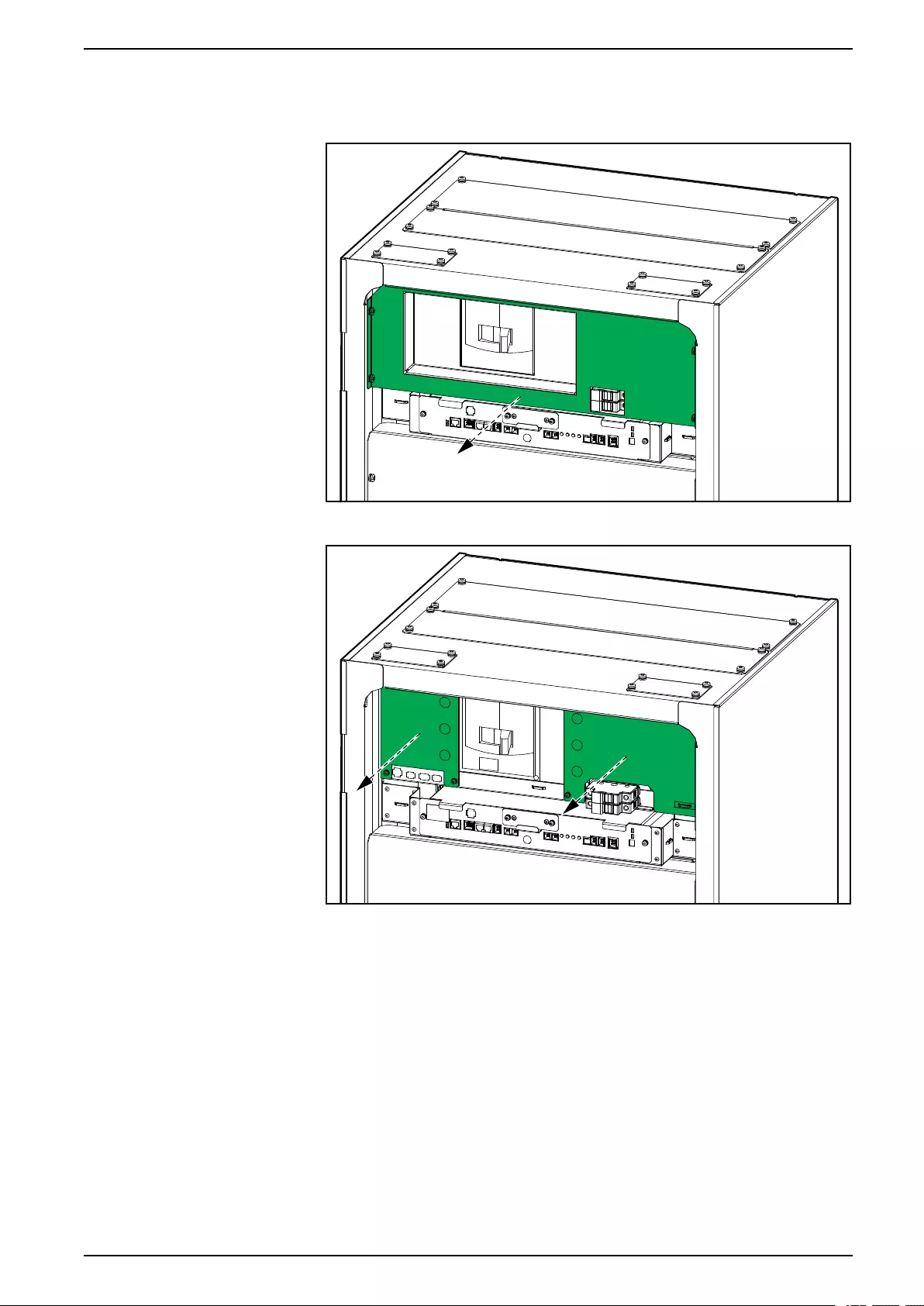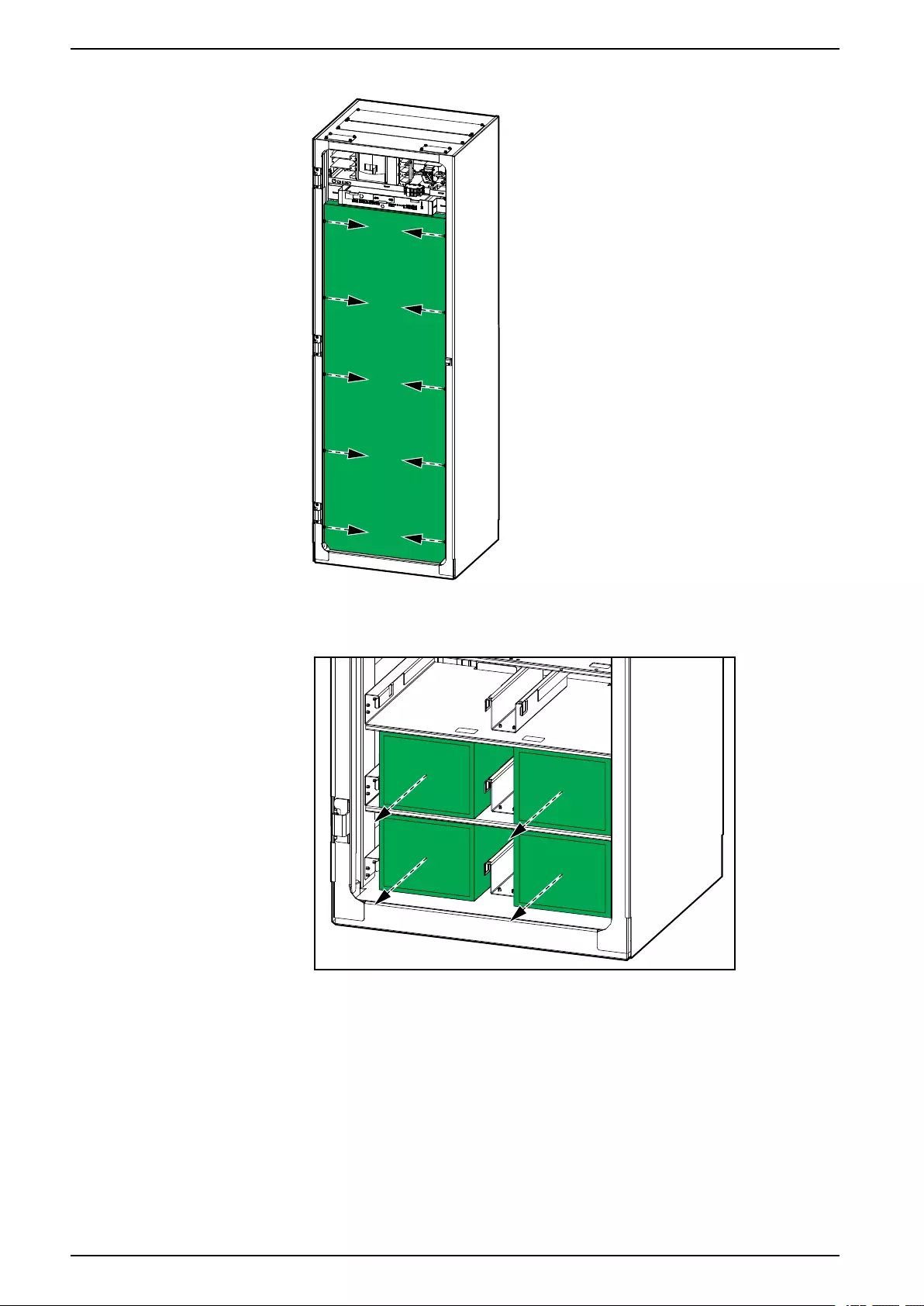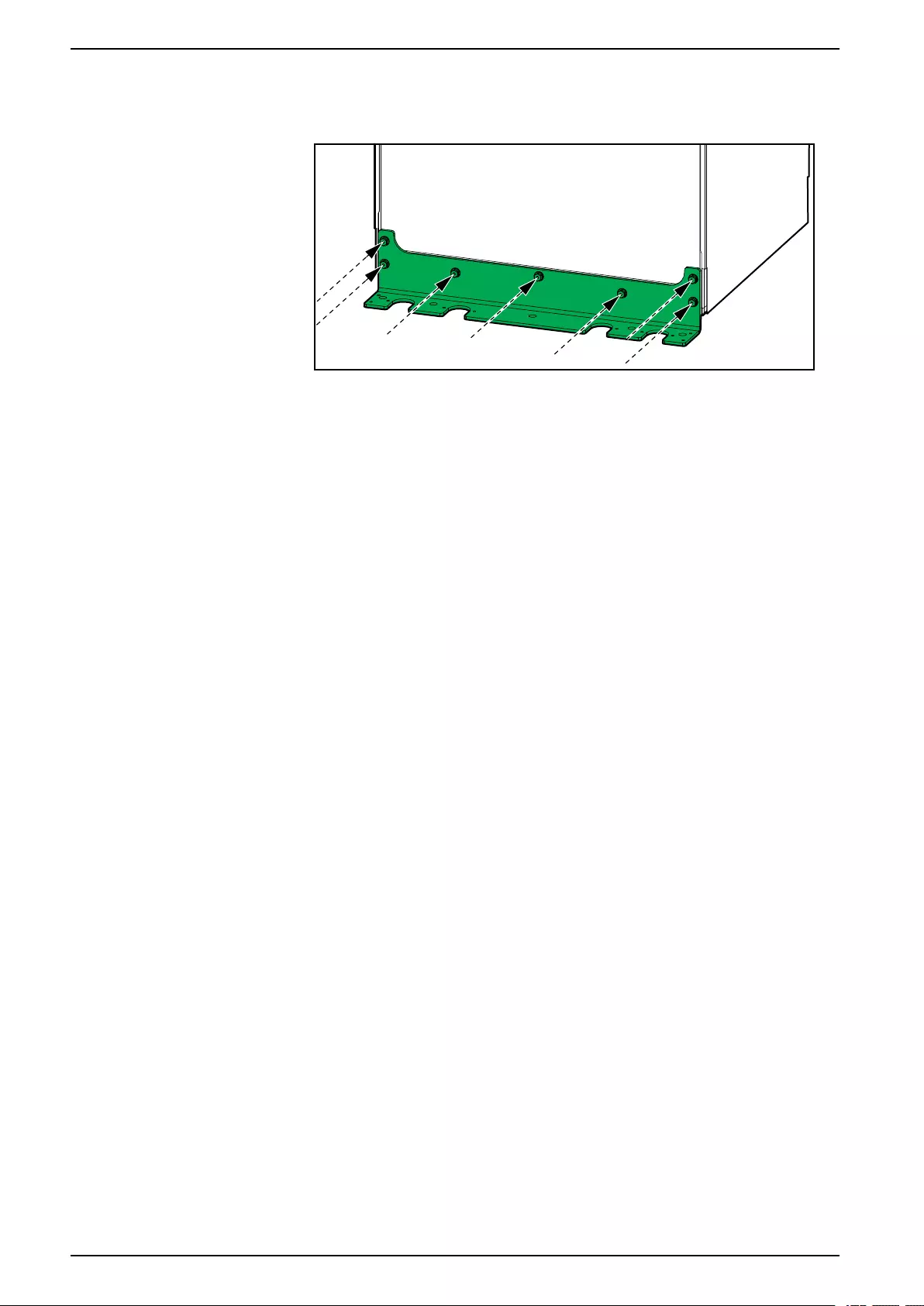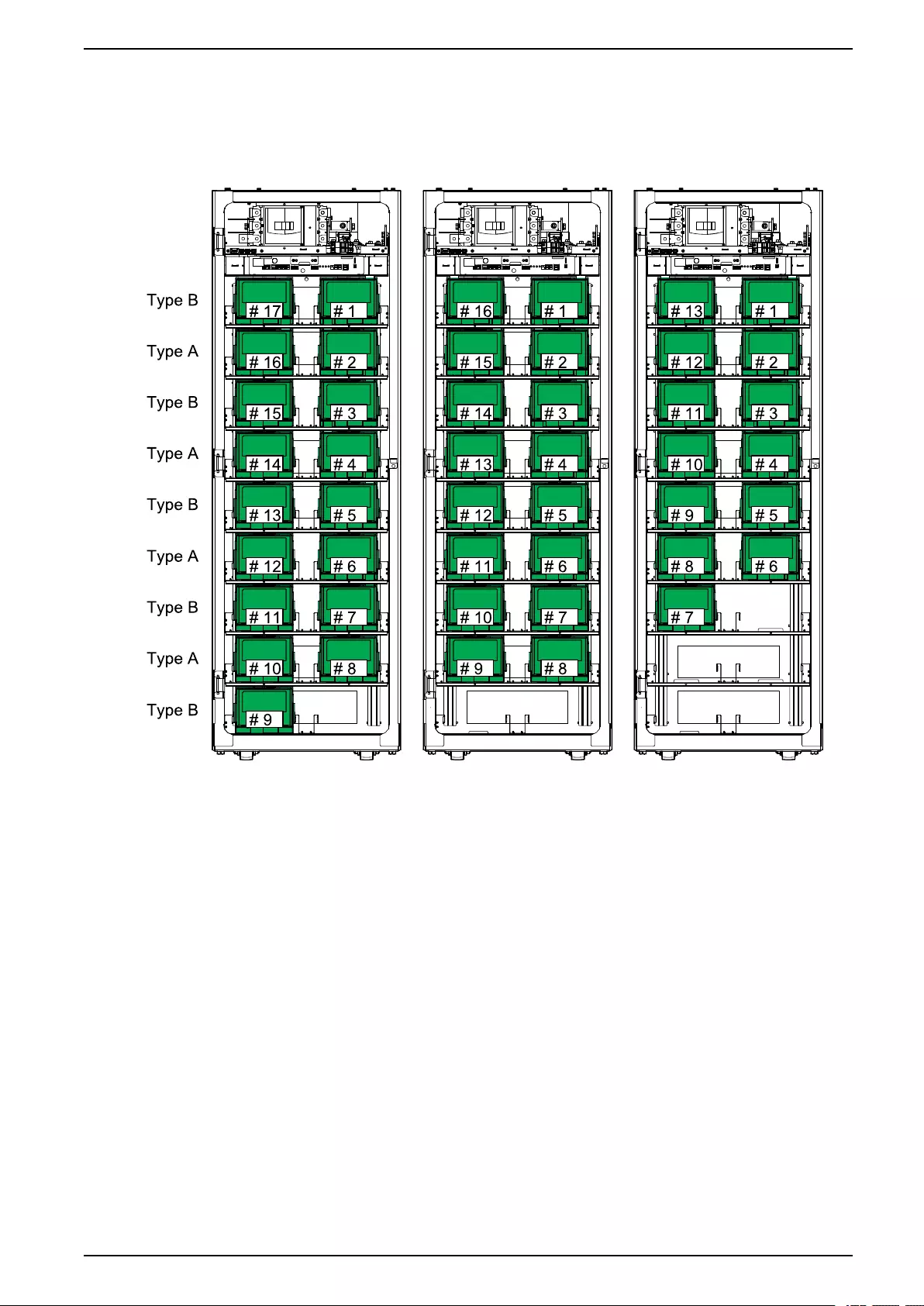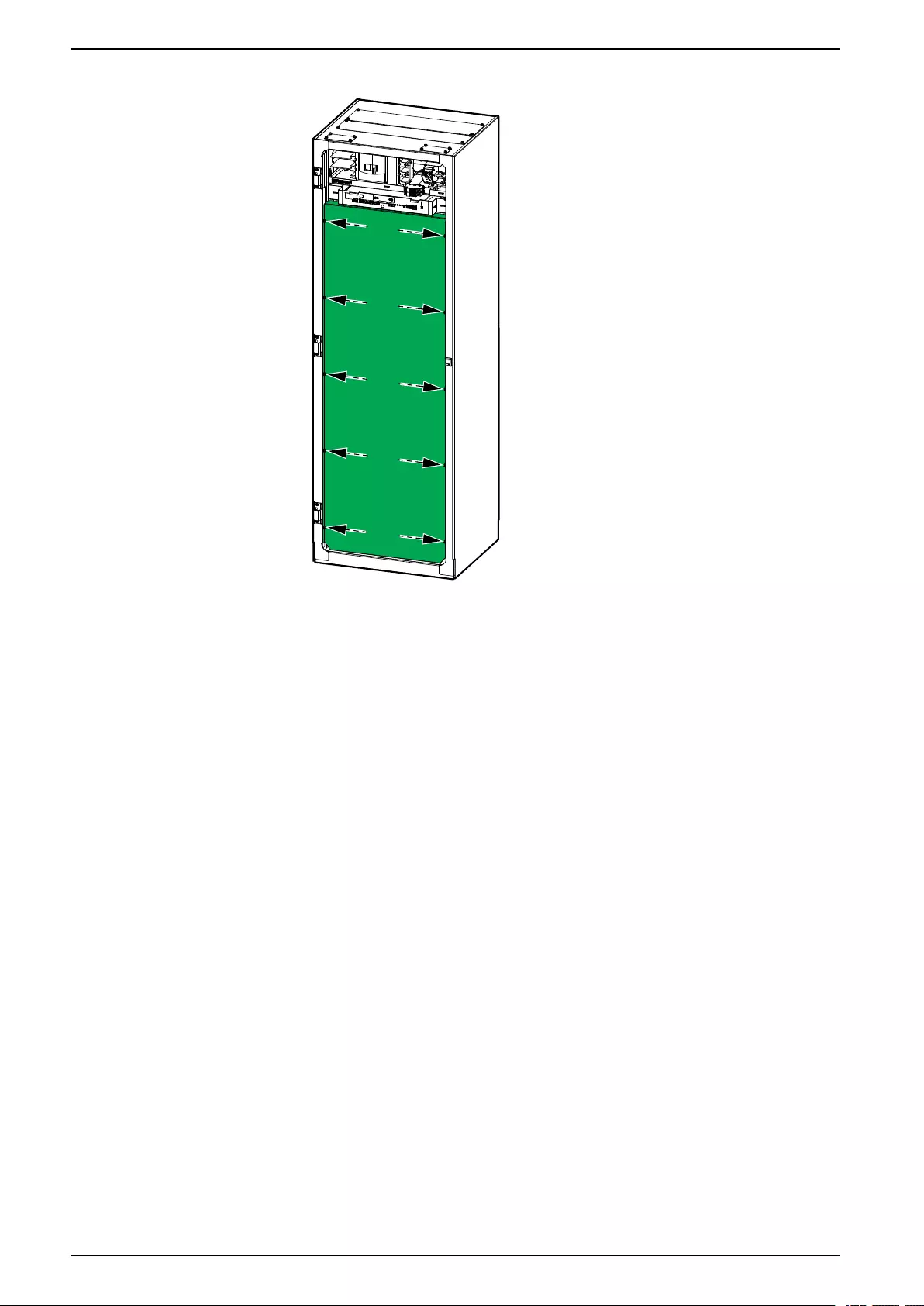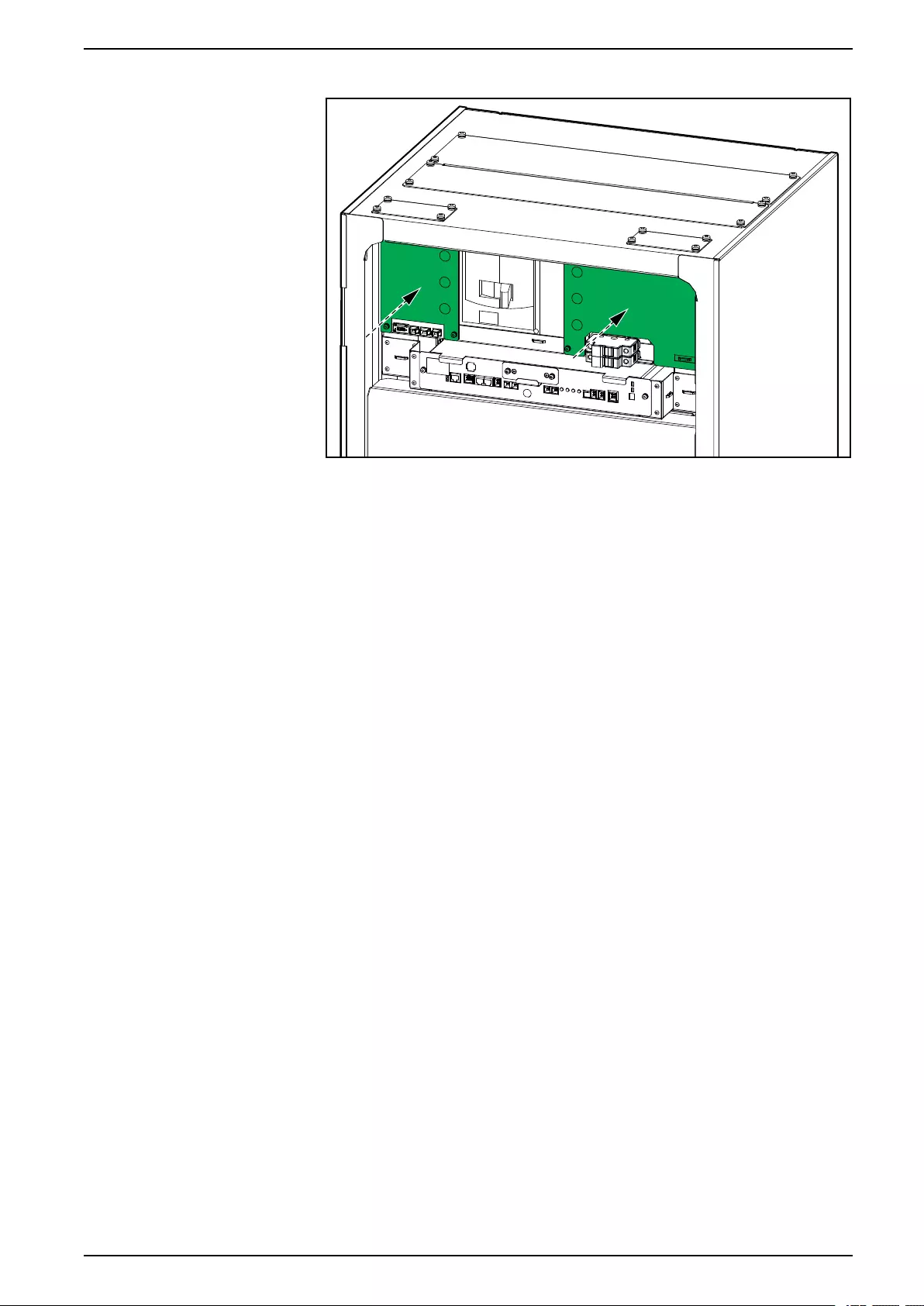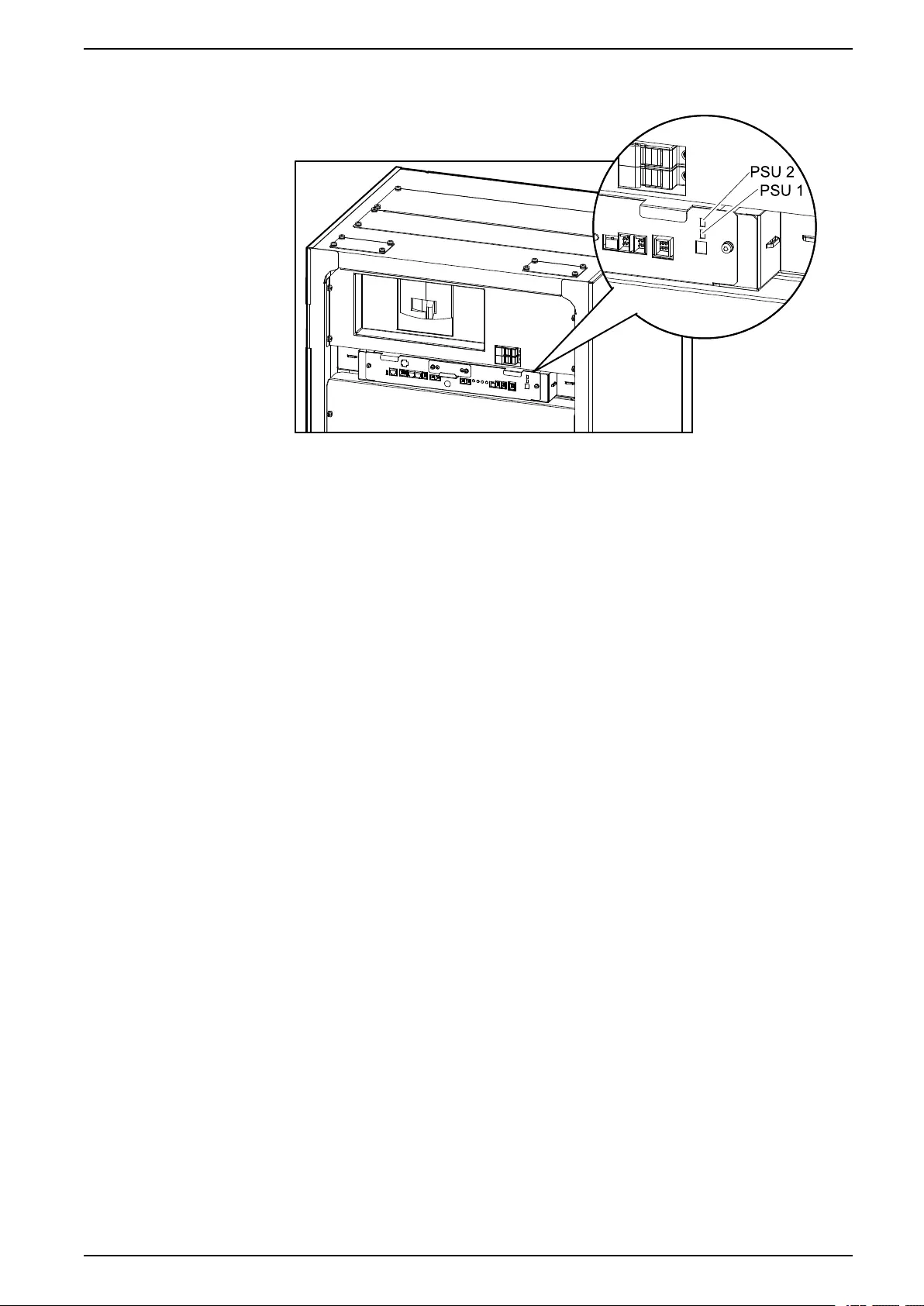Table of Contents
- Galaxy Lithium-ion Battery Cabinet
- Important Safety Instructions — SAVE THESE INSTRUCTIONS
- Specifications
- Overview of Accessory Kits
- Installation Procedure
- Prepare for Installation
- Install the Rear Seismic Anchoring
- Position and Interconnect the Battery Cabinets
- Install the Front Seismic Anchoring
- Install the Battery Modules in the Battery Cabinet
- Connect the Power Cables
- Overview of Communication Interface
- Route the Signal Cables to the Switchgear, Rack BMS, and System BMS Ports
- Operation Procedures
- Troubleshooting
- Blank Page
- Blank Page
APC LIBSESMG16UL User Manual
Displayed below is the user manual for LIBSESMG16UL by APC which is a product in the UPS Battery Cabinets category. This manual has pages.
Related Manuals
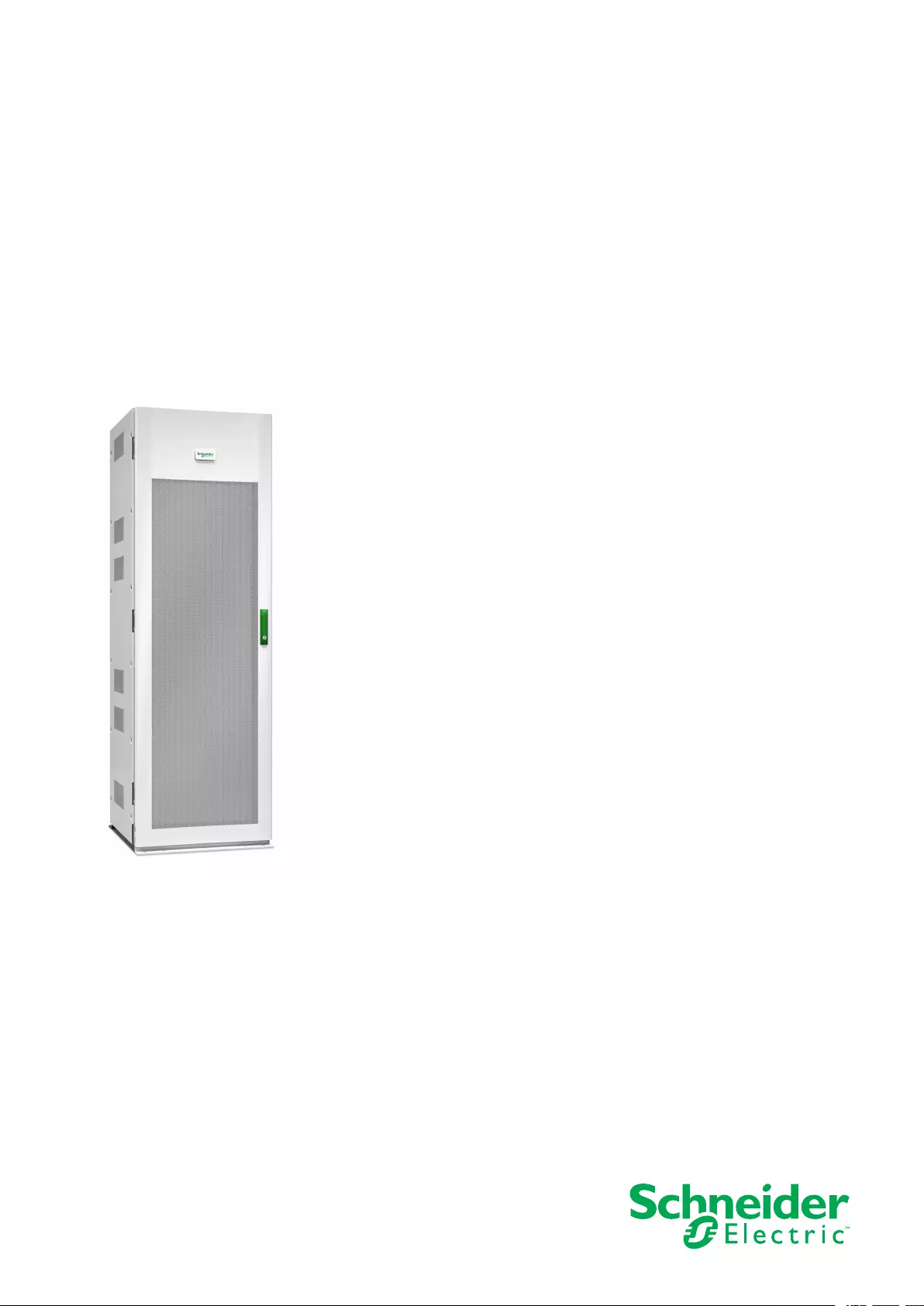
Galaxy Lithium-ion Battery Cabinet
With 13, 16, or 17 Battery Modules
Installation and Operation
LIBSESMG13IEC, LIBSESMG16IEC, LIBSESMG17IEC
LIBSESMG13UL, LIBSESMG16UL, LIBSESMG17UL
Latest updates are available on the Schneider Electric website
5/2021
www.se.com

Legal Information
The Schneider Electric brand and any trademarks of Schneider Electric SE and its
subsidiaries referred to in this guide are the property of Schneider Electric SE or its
subsidiaries. All other brands may be trademarks of their respective owners.
This guide and its content are protected under applicable copyright laws and
furnished for informational use only. No part of this guide may be reproduced or
transmitted in any form or by any means (electronic, mechanical, photocopying,
recording, or otherwise), for any purpose, without the prior written permission of
Schneider Electric.
Schneider Electric does not grant any right or license for commercial use of the guide
or its content, except for a non-exclusive and personal license to consult it on an "as
is" basis. Schneider Electric products and equipment should be installed, operated,
serviced, and maintained only by qualified personnel.
As standards, specifications, and designs change from time to time, information
contained in this guide may be subject to change without notice.
To the extent permitted by applicable law, no responsibility or liability is assumed by
Schneider Electric and its subsidiaries for any errors or omissions in the informational
content of this material or consequences arising out of or resulting from the use of the
information contained herein.
Go to https://www.productinfo.schneider-electric.com/galaxyliion/
or scan the QR code above for digital experience and translated manuals.

With 13, 16, or 17 Battery Modules
Table of Contents
Important Safety Instructions — SAVE THESE
INSTRUCTIONS.........................................................................................5
FCC Statement ..........................................................................................6
Electromagnetic Compatibility .....................................................................6
Safety Precautions .....................................................................................6
Electrical Safety .........................................................................................8
Battery Safety ............................................................................................9
Specifications ............................................................................................10
Recommended Cable Sizes ......................................................................10
Recommended Cable Lugs.......................................................................11
Torque Specifications................................................................................11
Weights and Dimensions........................................................................... 11
Clearance ................................................................................................12
Environment.............................................................................................12
Overview of Accessory Kits.....................................................................13
Installation Procedure ..............................................................................14
Prepare for Installation..............................................................................15
Install the Rear Seismic Anchoring.............................................................17
Position and Interconnect the Battery Cabinets ...........................................19
Install the Front Seismic Anchoring ............................................................21
Install the Battery Modules in the Battery Cabinet........................................22
Connect the Power Cables........................................................................25
Overview of Communication Interface........................................................28
Route the Signal Cables to the Switchgear, Rack BMS, and System BMS
Ports .......................................................................................................29
Overview of Signal Cables between the Battery Cabinets and the
Auxiliary Contacts in the UPS ..............................................................32
Overview of Signal Cables for Alarms and Battery Breaker Trip ..............33
Overview of CAN Bus Cables between the Battery Cabinets ..................34
Overview of EPO Signal Cables...........................................................34
Operation Procedures..............................................................................35
Shut Down the Battery Solution .................................................................35
Restart the Battery Solution.......................................................................35
Troubleshooting ........................................................................................36
Status LEDs.............................................................................................36
PSU LEDs ...............................................................................................37
Alarm List.................................................................................................38
Protection Protocols............................................................................38
990-91430A-001 3

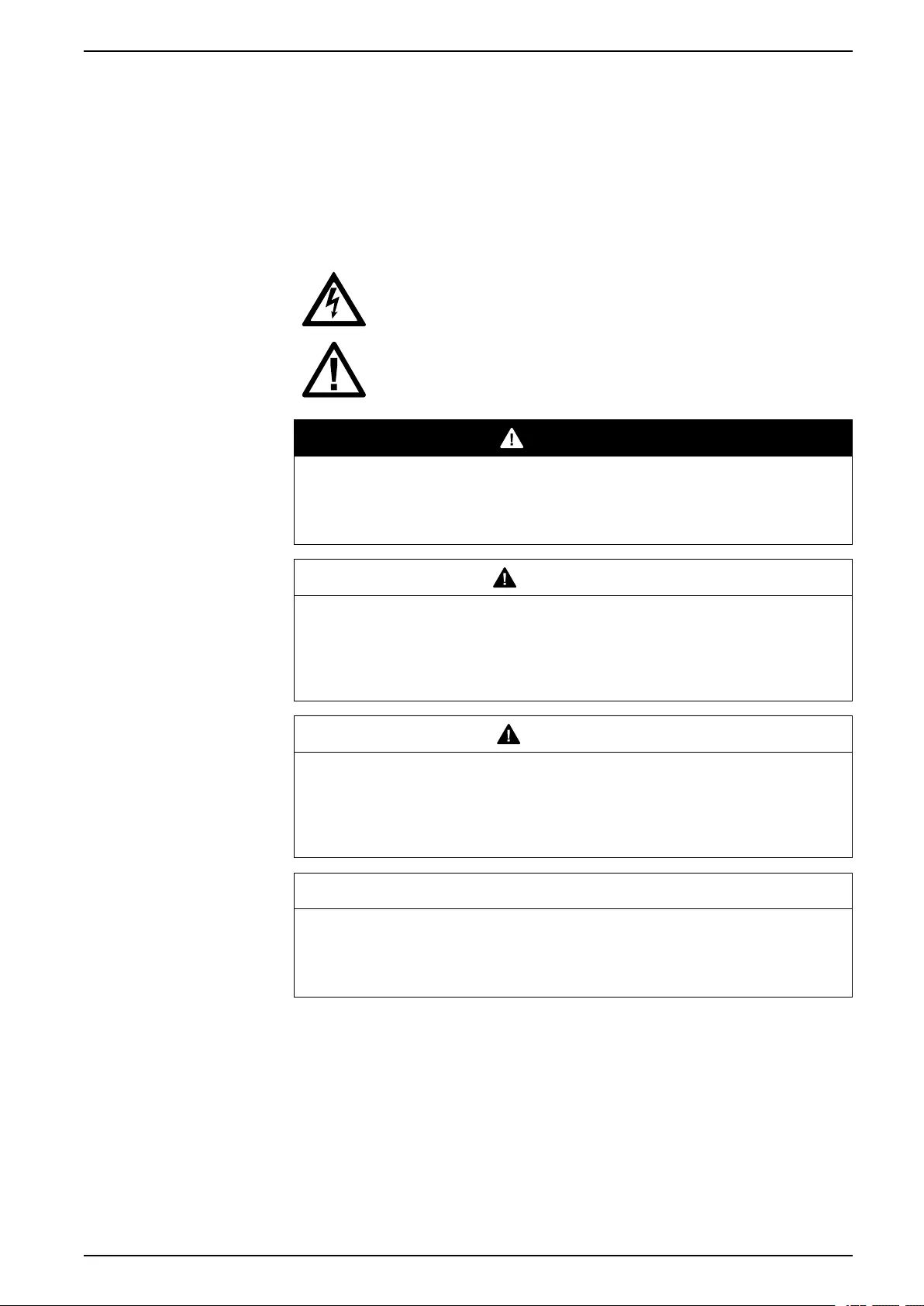
Important Safety Instructions — SAVE THESE
INSTRUCTIONS With 13, 16, or 17 Battery Modules
Important Safety Instructions — SAVE THESE
INSTRUCTIONS
Read these instructions carefully and look at the equipment to become familiar
with it before trying to install, operate, service or maintain it. The following safety
messages may appear throughout this manual or on the equipment to warn of
potential hazards or to call attention to information that clarifies or simplifies a
procedure.
The addition of this symbol to a “Danger” or “Warning” safety
message indicates that an electrical hazard exists which will result in
personal injury if the instructions are not followed.
This is the safety alert symbol. It is used to alert you to potential
personal injury hazards. Obey all safety messages with this symbol
to avoid possible injury or death.
DANGER
DANGER indicates a hazardous situation which, if not avoided, will result in
death or serious injury.
Failure to follow these instructions will result in death or serious injury.
WARNING
WARNING indicates a hazardous situation which, if not avoided, could result
in death or serious injury.
Failure to follow these instructions can result in death, serious injury, or
equipment damage.
CAUTION
CAUTION indicates a hazardous situation which, if not avoided, could result in
minor or moderate injury.
Failure to follow these instructions can result in injury or equipment
damage.
NOTICE
NOTICE is used to address practices not related to physical injury. The safety
alert symbol shall not be used with this type of safety message.
Failure to follow these instructions can result in equipment damage.
Please Note
Electrical equipment should only be installed, operated, serviced, and maintained
by qualified personnel. No responsibility is assumed by Schneider Electric for any
consequences arising out of the use of this material.
A qualified person is one who has skills and knowledge related to the construction,
installation, and operation of electrical equipment and has received safety training
to recognize and avoid the hazards involved.
990-91430A-001 5
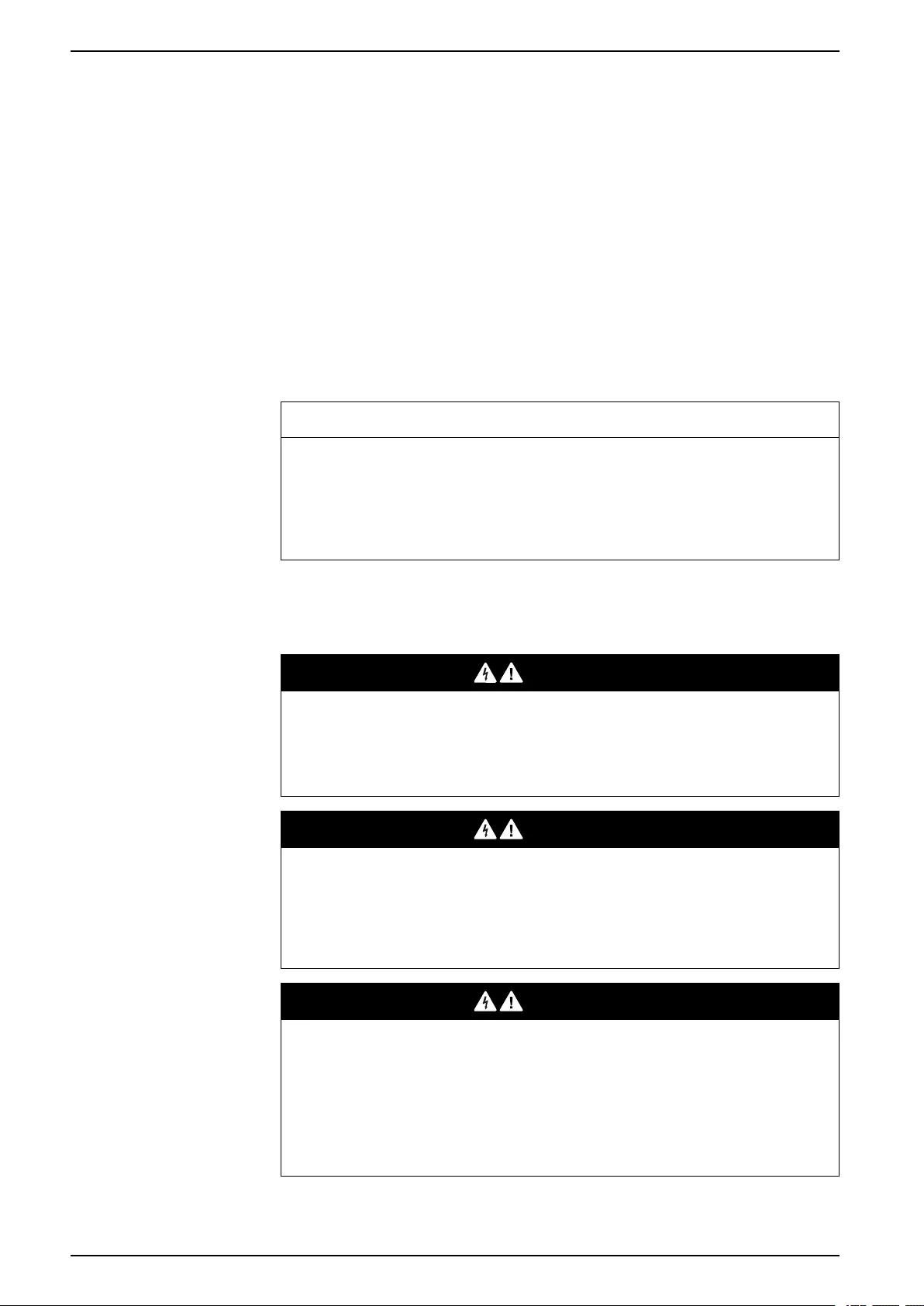
With 13, 16, or 17 Battery Modules Important Safety Instructions — SAVE THESE
INSTRUCTIONS
FCC Statement
NOTE: This equipment has been tested and found to comply with the limits for
a Class A digital device, pursuant to Part 15 of the FCC Rules. These limits
are designed to provide reasonable protection against harmful interference
when the equipment is operated in a commercial environment. This equipment
generates, uses, and can radiate radio frequency energy and, if not installed
and used in accordance with the instruction manual, may cause harmful
interference to radio communications. Operation of this equipment in a
residential area is likely to cause harmful interference in which case the user
will be required to correct the interference at his own expense.
Any changes or modifications not expressly approved by the party responsible for
compliance could void the user’s authority to operate the equipment.
Electromagnetic Compatibility
NOTICE
RISK OF ELECTROMAGNETIC DISTURBANCE
This is a product category C2 UPS product. In a residential environment, this
product may cause radio inference, in which case the user may be required to
take additional measures.
Failure to follow these instructions can result in equipment damage.
Safety Precautions
DANGER
HAZARD OF ELECTRIC SHOCK, EXPLOSION, OR ARC FLASH
Read all instructions in the installation manual before installing or working on
this product.
Failure to follow these instructions will result in death or serious injury.
DANGER
HAZARD OF ELECTRIC SHOCK, EXPLOSION, OR ARC FLASH
• Do not install the product until all construction work has been completed and
the installation room has been cleaned.
• Build a clear, permanent, restricted access area around the system.
Failure to follow these instructions will result in death or serious injury.
DANGER
HAZARD OF ELECTRIC SHOCK, EXPLOSION, OR ARC FLASH
The product must be installed according to the specifications and requirements
as defined by Schneider Electric. It concerns in particular the external and
internal protections (upstream breakers, battery breakers, cabling, etc.) and
environmental requirements. No responsibility is assumed by Schneider Electric
if these requirements are not respected.
Failure to follow these instructions will result in death or serious injury.
6 990-91430A-001
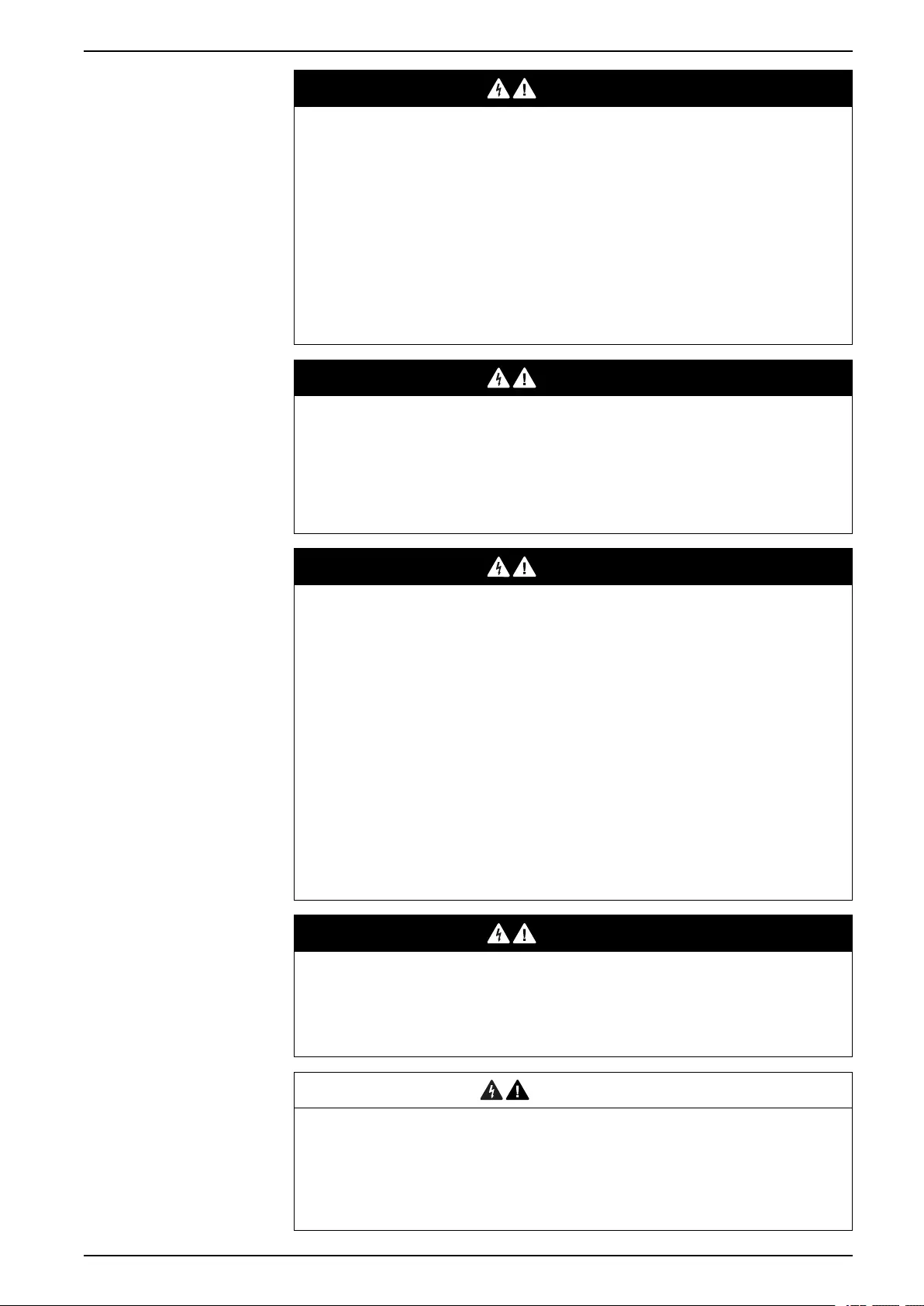
Important Safety Instructions — SAVE THESE
INSTRUCTIONS With 13, 16, or 17 Battery Modules
DANGER
HAZARD OF ELECTRIC SHOCK, EXPLOSION, OR ARC FLASH
The UPS system must be installed according to local and national regulations.
Install the UPS according to:
• IEC 60364 (including 60364–4–41- protection against electric shock, 60364–
4–42 - protection against thermal effect, and 60364–4–43 - protection
against overcurrent), or
• NEC NFPA 70, or
• Canadian Electrical Code (C22.1, Part 1)
depending on which one of the standards apply in your local area.
Failure to follow these instructions will result in death or serious injury.
DANGER
HAZARD OF ELECTRIC SHOCK, EXPLOSION, OR ARC FLASH
• Install the product in a temperature controlled indoor environment free of
conductive contaminants and humidity.
• Install the product on a non-flammable, level and solid surface (e.g.
concrete) that can support the weight of the system.
Failure to follow these instructions will result in death or serious injury.
DANGER
HAZARD OF ELECTRIC SHOCK, EXPLOSION, OR ARC FLASH
The product is not designed for and must therefore not be installed in the
following unusual operating environments:
• Damaging fumes
• Explosive mixtures of dust or gases, corrosive gases, or conductive or
radiant heat from other sources
• Moisture, abrasive dust, steam or in an excessively damp environment
• Fungus, insects, vermin
• Salt-laden air or contaminated cooling refrigerant
• Pollution degree higher than 2 according to IEC 60664-1
• Exposure to abnormal vibrations, shocks, and tilting
• Exposure to direct sunlight, heat sources, or strong electromagnetic fields
Failure to follow these instructions will result in death or serious injury.
DANGER
HAZARD OF ELECTRIC SHOCK, EXPLOSION, OR ARC FLASH
Do not drill or cut holes for cables or conduits with the gland plates installed and
do not drill or cut holes in close proximity to the product.
Failure to follow these instructions will result in death or serious injury.
WARNING
HAZARD OF ARC FLASH
Do not make mechanical changes to the product (including removal of cabinet
parts or drilling/cutting of holes) that are not described in the installation manual.
Failure to follow these instructions can result in death, serious injury, or
equipment damage.
990-91430A-001 7
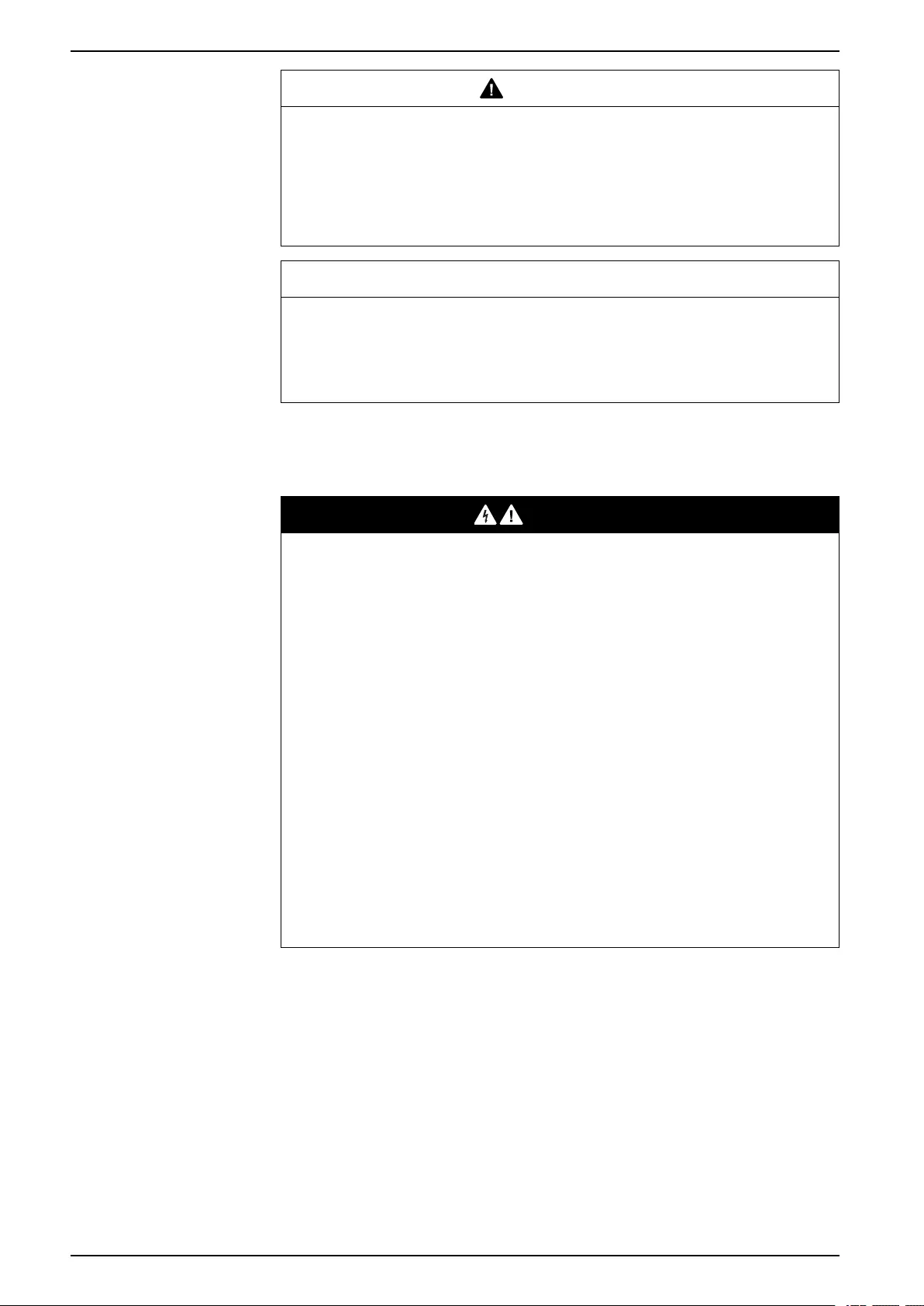
With 13, 16, or 17 Battery Modules Important Safety Instructions — SAVE THESE
INSTRUCTIONS
WARNING
CHEMICAL HAZARD
This product can expose you to chemicals including Tetrabromobisphenol A,
which is known to the State of California to cause cancer. For more information,
go to www.P65Warnings.ca.gov
Failure to follow these instructions can result in death, serious injury, or
equipment damage.
NOTICE
RISK OF OVERHEATING
Respect the space requirements around the product and do not cover the
ventilation openings when the product is in operation.
Failure to follow these instructions can result in equipment damage.
Electrical Safety
DANGER
HAZARD OF ELECTRIC SHOCK, EXPLOSION OR ARC FLASH
• Electrical equipment must be installed, operated, serviced, and maintained
only by qualified personnel.
• Apply appropriate personal protective equipment (PPE) and follow safe
electrical work practices.
• Turn off all power supplying the UPS system before working on or inside the
equipment.
• Before working on the UPS system, check for hazardous voltage between all
terminals including the protective earth.
• The battery cabinet contains an internal energy source. Hazardous voltage
can be present even when the UPS system is disconnected from the utility/
mains supply. Before installing or servicing the UPS system, ensure that the
units are OFF and that utility/mains and batteries are disconnected.
• A disconnection device (e.g. disconnection circuit breaker or switch) must be
installed to enable isolation of the system from upstream power sources in
accordance with local regulations. This disconnection device must be easily
accessible and visible.
• The battery cabinet must be properly earthed/grounded and due to a high
leakage current, the earthing/grounding conductor must be connected first.
Failure to follow these instructions will result in death or serious injury.
8 990-91430A-001

Important Safety Instructions — SAVE THESE
INSTRUCTIONS With 13, 16, or 17 Battery Modules
Battery Safety
DANGER
HAZARD OF ELECTRIC SHOCK, EXPLOSION, OR ARC FLASH
• Battery circuit breakers must be installed according to the specifications and
requirements as defined by Schneider Electric.
• Servicing of batteries must only be performed or supervised by qualified
personnel knowledgeable of batteries and the required precautions. Keep
unqualified personnel away from batteries.
• Disconnect charging source prior to connecting or disconnecting battery
terminals.
• Do not dispose of batteries in a fire as they can explode.
• Do not open, alter, or mutilate batteries.
Failure to follow these instructions will result in death or serious injury.
DANGER
HAZARD OF ELECTRIC SHOCK, EXPLOSION, OR ARC FLASH
Batteries can present a risk of electric shock and high short-circuit current. The
following precautions must be observed when working on batteries
• Remove watches, rings, or other metal objects.
• Use tools with insulated handles.
• Wear protective glasses, gloves and boots.
• Do not lay tools or metal parts on top of batteries.
• Disconnect the charging source prior to connecting or disconnecting battery
terminals.
• Determine if the battery is inadvertently grounded. If inadvertently grounded,
remove source from ground. Contact with any part of a grounded battery can
result in electric shock. The likelihood of such shock can be reduced if such
grounds are removed during installation and maintenance (applicable to
equipment and remote battery supplies not having a grounded supply
circuit).
Failure to follow these instructions will result in death or serious injury.
DANGER
HAZARD OF ELECTRIC SHOCK, EXPLOSION, OR ARC FLASH
When replacing batteries, always replace with the same battery module type.
Failure to follow these instructions will result in death or serious injury.
NOTICE
RISK OF EQUIPMENT DAMAGE
• Batteries should not be stored beyond 12 months from the date of
production. If they are stored for longer the calendar degradation will cause
the batteries to be irreversible degraded beyond what is expected – a
reduced runtime will be the consequence. Performance guarantee will be
measured from the time of deployment or from production date +12 months,
whichever comes first. For storage beyond 12 months, contact Schneider
Electric.
• If the UPS system remains de-energized for a long period, Schneider
Electric recommends to shut down the battery cabinet completely.
Failure to follow these instructions can result in equipment damage.
990-91430A-001 9
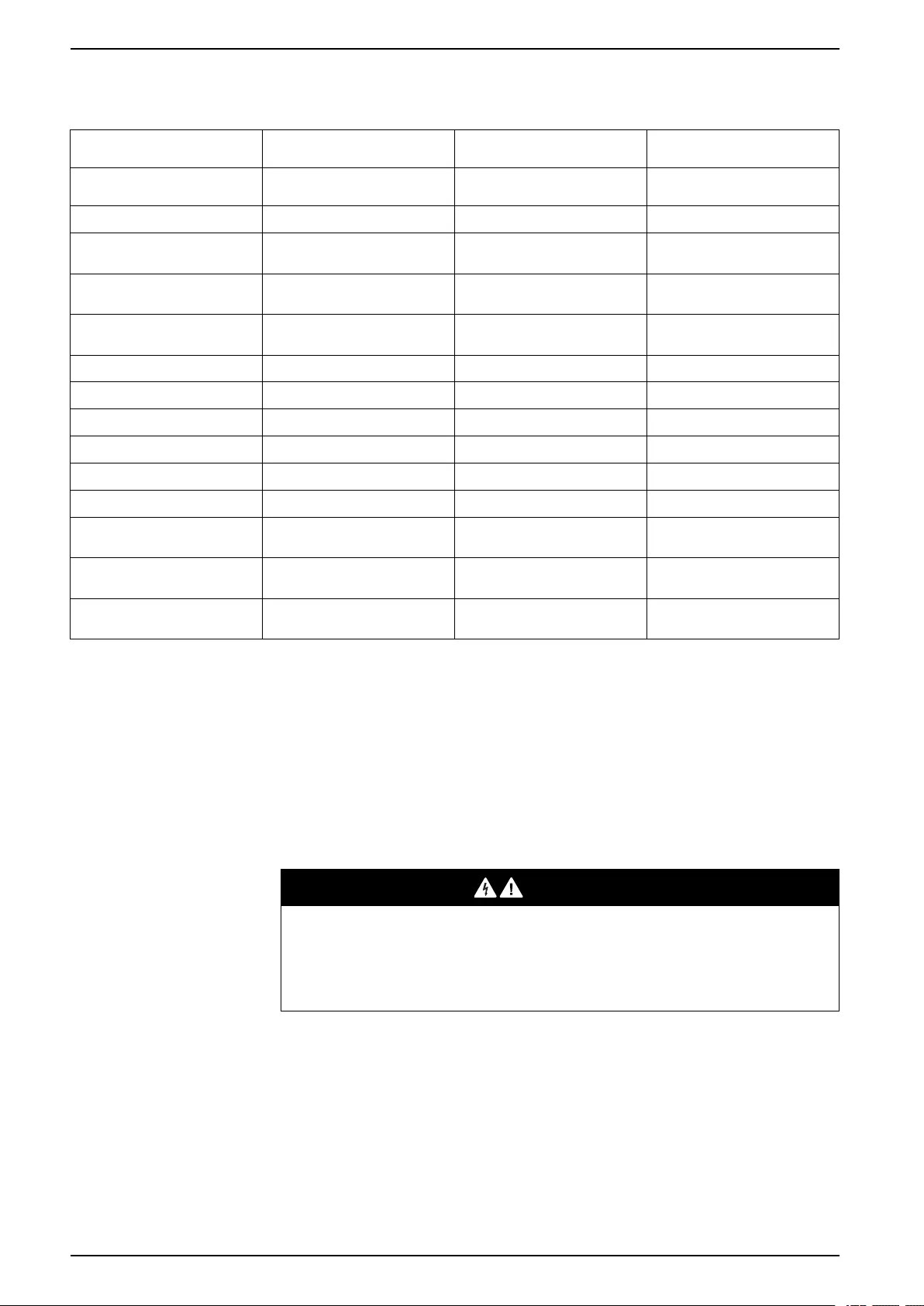
With 13, 16, or 17 Battery Modules Specifications
Specifications
Commercial reference LIBSESMG13IEC/
LIBSESMG13UL
LIBSESMG16IEC/
LIBSESMG16UL
LIBSESMG17IEC/
LIBSESMG17UL
Battery designation IMP46/175/127/[(8S)13S]M/-20
+60/90 IMP46/175/127/[(8S)16S]M/-20
+60/90 IMP46/175/127/[(8S)17S]M/-20
+60/90
Number of battery modules 13 16 17
Number of type A battery
modules (LIBSMG95MODA) 6 8 8
Number of type B battery
modules (LIBSMG95MODB) 7 8 9
Number of battery cells in a
string 104 128 136
Nominal energy (kWh) 26.5 32.6 34.6
Nominal battery voltage (VDC) 395 486 517
Nominal capacity (Ah) 67 67 67
Charge current rate (CA rate) 0.7 0.7 0.7
Float charge voltage (VDC) 436 537 571
End of discharge voltage (VDC) 312 384 408
Maximum continuous discharge
power (kW) 140 173 184
Peak current at end of
discharge (A) 450 450 450
Maximum short circuit current
(kA) 9.0 9.0 9.0
NOTE: If the battery temperature is higher than the threshold after a full
discharge at maximum continuous discharge power, the UPS may have to
reduce the charge current to zero to protect the battery.
NOTE: The battery temperature must return to ±3 °C / ±37.4 °F of the room
temperature before a new discharge at maximum continuous discharge
power. If not, the battery breaker may be tripped due to overtemperature
protection.
Recommended Cable Sizes
DANGER
HAZARD OF ELECTRIC SHOCK, EXPLOSION, OR ARC FLASH
All wiring must comply with all applicable national and/or electrical codes. The
maximum allowable cable size is 185 mm² (IEC) / 350 kcmil (UL).
Failure to follow these instructions will result in death or serious injury.
NOTE: Refer to the UPS installation manual for recommended cable sizes.
10 990-91430A-001

Specifications With 13, 16, or 17 Battery Modules
Recommended Cable Lugs
Copper – One Hole Cable Lug
Cable size Bolt size Cable lug type Crimp tool Die
3/0 AWG M10x30 LCA3/0-12-X CT-720 CD-720-2 Orange P50
4/0 AWG M10x30 LCA4/0-12-X CT-720 CD-720-3 Purple P54
300 kcmil M10x30 LCA300-12-X CT-720 CD-720-4 White P66
350 kcmil M10x30 LCA350-12-X CT-720 CD-720-5 Red P71
Copper – Two Hole Cable Lug
Cable size Bolt size Cable lug type Crimp tool Die
3/0 AWG M10x30 LCC3/0-12D-X CT-930 CD-920-3/0 Orange P50
4/0 AWG M10x30 LCC4/0-12D-X CT-930 CD-920-4/0 Purple P54
300 kcmil M10x30 LCC300-12-X CT-930 CD-920-300 White P66
350 kcmil M10x30 LCC350-12-X CT-930 CD-920-350 Red P71
Torque Specifications
Bolt size Torque
M4 1.7 Nm (1.25 lb-ft)
M6 5 Nm (3.69 lb-ft)
M8 14 Nm (10.33 lb-ft)
M10 30 Nm (22.13 lb-ft)
M12 46 Nm (33.93 lb-ft)
Weights and Dimensions
Commercial reference Weight kg (lbs) Height mm (in) Width mm (in) Depth mm (in)
LIBSESMG13IEC/
LIBSESMG13UL 415 (915) 1970 (77.56) 650 (25.59) 587 (23.11)
LIBSESMG16IEC/
LIBSESMG16UL 470 (1036) 1970 (77.56) 650 (25.59) 587 (23.11)
LIBSESMG17IEC/
LIBSESMG17UL 490 (1080) 1970 (77.56) 650 (25.59) 587 (23.11)
990-91430A-001 11
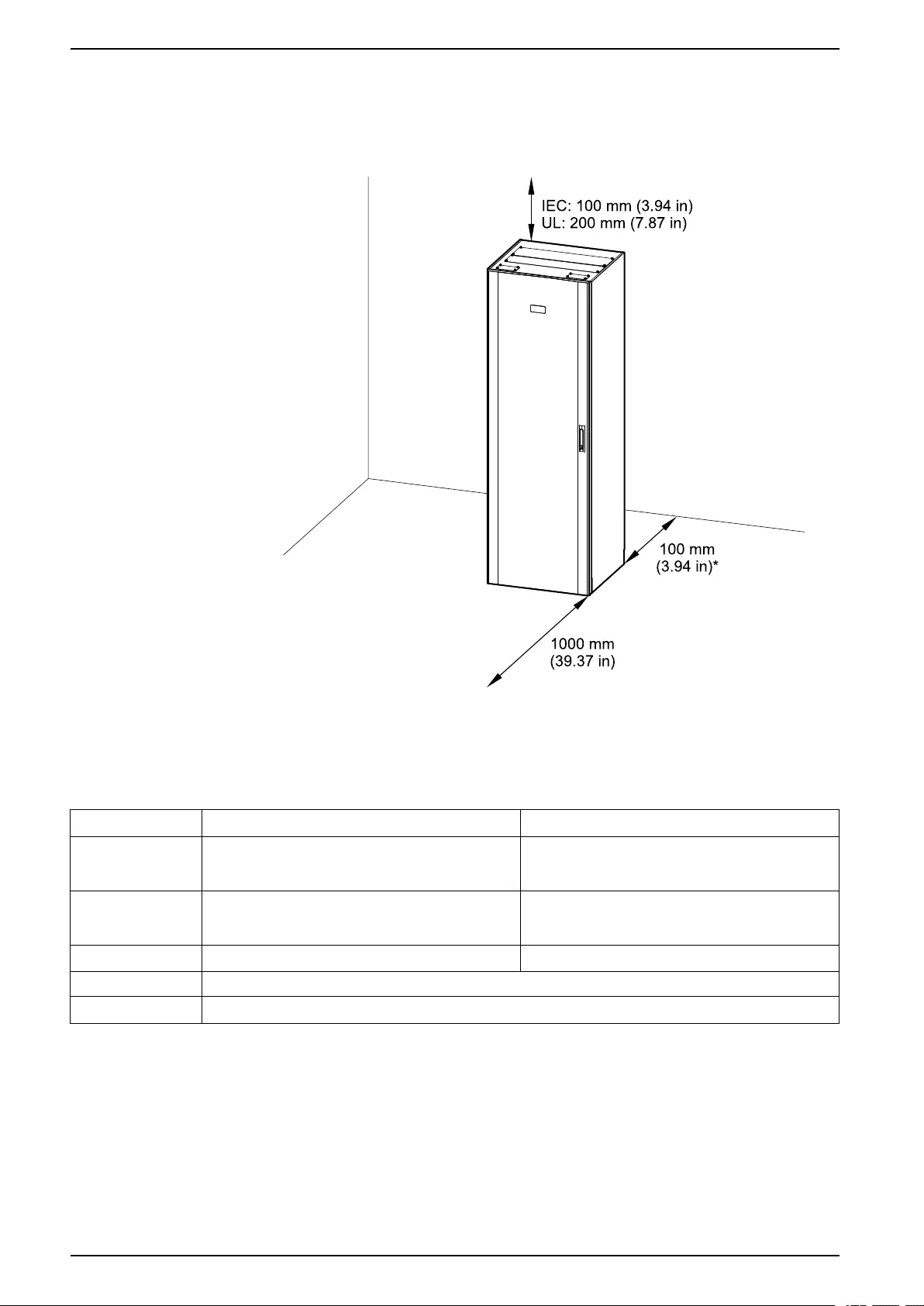
With 13, 16, or 17 Battery Modules Specifications
Clearance
NOTE: Clearance dimensions are published for airflow and service access
only. Consult with the local safety codes and standards for additional
requirements in your local area.
* For system with seismic anchoring.
Environment
Operating Storage
Temperature Recommended operating temperature: 18 to 28 °C (64
to 82 °F) Battery cabinet: 0 °C to 40 °C (32 °F to 104 °F)
Battery modules: Recommended storage for battery
modules is 20 °C (68 °F) or cooler (non-freezing)
Relative humidity 0-95% non-condensing Battery cabinet: 0-90% non-condensing
Battery modules: Recommended storage for battery
modules is 40-80% non-condensing
Elevation 0-3000 m (0-10000 feet)
Protection class IP20
Color RAL 9003, gloss level 85%
12 990-91430A-001

Overview of Accessory Kits With 13, 16, or 17 Battery Modules
Overview of Accessory Kits
Accessory Kit 0M-95318: Busbar Kit
NOTE: Save this accessory kit for the field service representative. The
busbars will be installed by Schneider Electric during the start-up service.
Accessory Kit 0M-95319: Cover Kit
NOTE: Save this accessory kit for the field service representative. The covers
will be installed by Schneider Electric during the start-up service.
Accessory Kit 0M-95320: Cable Kit
Part Number Description Quantity Used in
0W76926 Signal cable from battery module to
battery module – standard 15 Note: Save these signal cables for the
field service representative. These
signal cables will be installed by
Schneider Electric during the start-up
service.
0W76936 Signal cable from battery module to
battery module – long 1
0W76933 Signal cable from battery module to
RBMS 1
0W76928 Signal cable from RBMS CAN 2 to
RBMS CAN 1 in next battery cabinet 1Route the Signal Cables to the
Switchgear, Rack BMS, and System
BMS Ports, page 29
0W76929 Signal cable from MCCB AUX 1 to
UPS 1
0W76934 Signal cable from MCCB AUX 2 to
MCCB AUX 1 in next battery cabinet 1
0W13444 Signal cable from SGB I/O 1 to the
UPS 1
0W13442 Signal cable from SGB I/O 2 to the
UPS 1
0W76972 Signal cable from SGB I/O 1 to SGB I/
O 1 between the battery cabinets 1
Accessory Kit 0M-95331: Seismic Anchoring and Fuse Kit
Part Number Description Quantity Used in
870-50102 Anchor parts 4 Install the Rear Seismic Anchoring,
page 17
870-51172 Interconnection plate between seismic
brackets 1
803-0684 M6 x 12 torx screw with washer 4
803-0686 M6 x 16 torx with washer 18 Install the Rear Seismic Anchoring,
page 17 and Position and Interconnect
the Battery Cabinets, page 19
TME00409 500 A fast acting fuse 3 Note: Save for the field service
representative. The fuses will be
installed by Schneider Electric during
the start-up service.
HUA29593 Washer 6
HUA13751 M12 x 16 hexagonal screw 6
HUA41574 3 A rated fuse 2
990-91430A-001 13

With 13, 16, or 17 Battery Modules Installation Procedure
Installation Procedure
1. Prepare for Installation, page 15.
2. Install the Rear Seismic Anchoring, page 17.
3. Position and Interconnect the Battery Cabinets, page 19.
4. Install the Front Seismic Anchoring, page 21.
5. Install the Battery Modules in the Battery Cabinet, page 22.
6. Connect the Power Cables, page 25.
7. Route the Signal Cables to the Switchgear, Rack BMS, and System BMS
Ports, page 29.
14 990-91430A-001
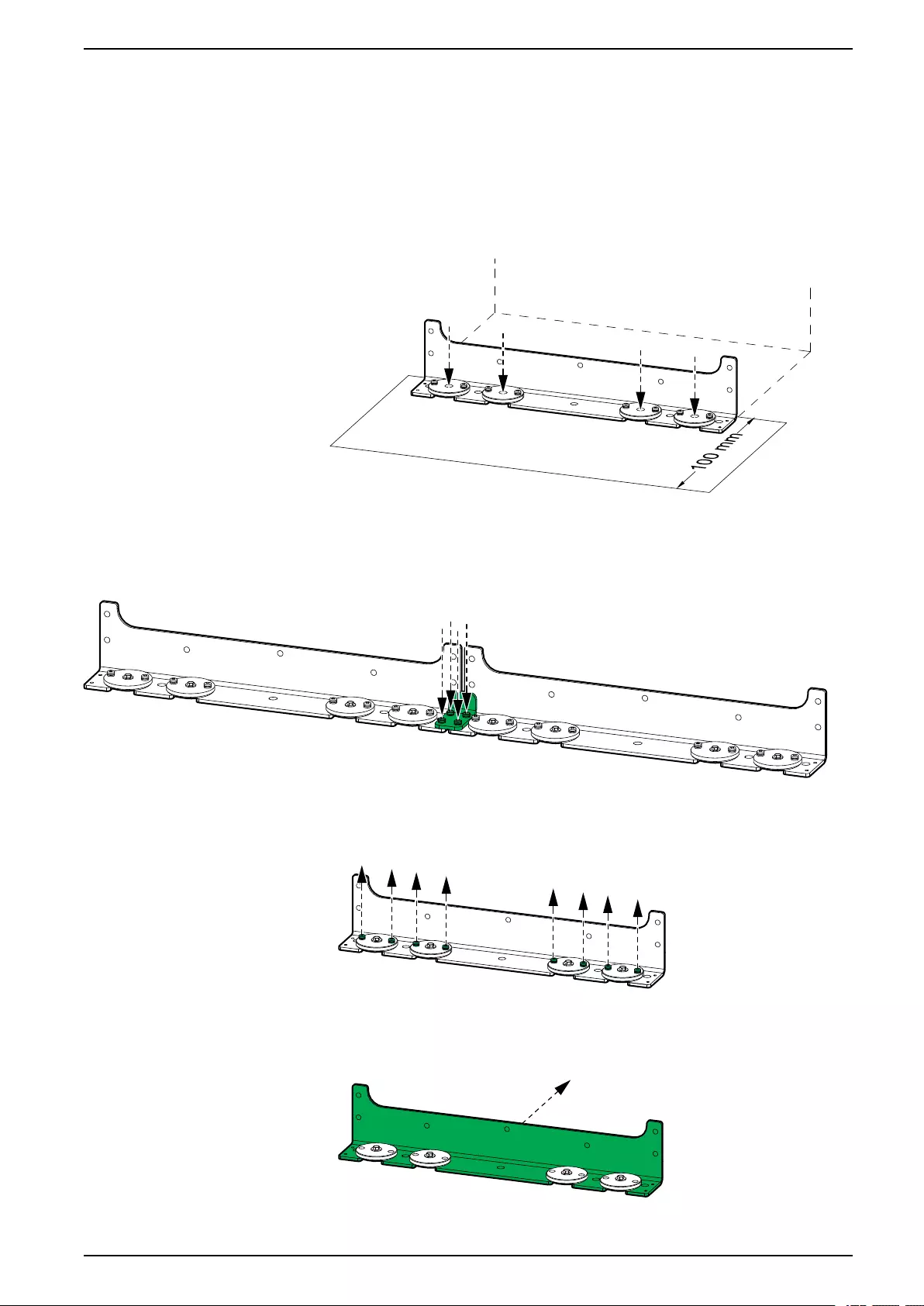
Installation Procedure With 13, 16, or 17 Battery Modules
Install the Rear Seismic Anchoring
1. Mount the rear seismic assembly (4 x 870-50102 and M6 x 16 torx screws
from accessory kit 0M-95331 and the rear shipping bracket) to the floor. Use
appropriate hardware for the floor type – the hole diameter in the rear seismic
bracket is ø14 mm. The minimum requirement is M12 strength grade 8.8
hardware.
Rear View
2. In systems with more battery cabinets, interconnect the seismic assemblies
with the interconnection plate 870-51172 from the accessory kit 0M-95331.
Rear View
3. Remove the indicated screws.
Rear View
4. Remove the rear seismic bracket.
Rear View
990-91430A-001 17
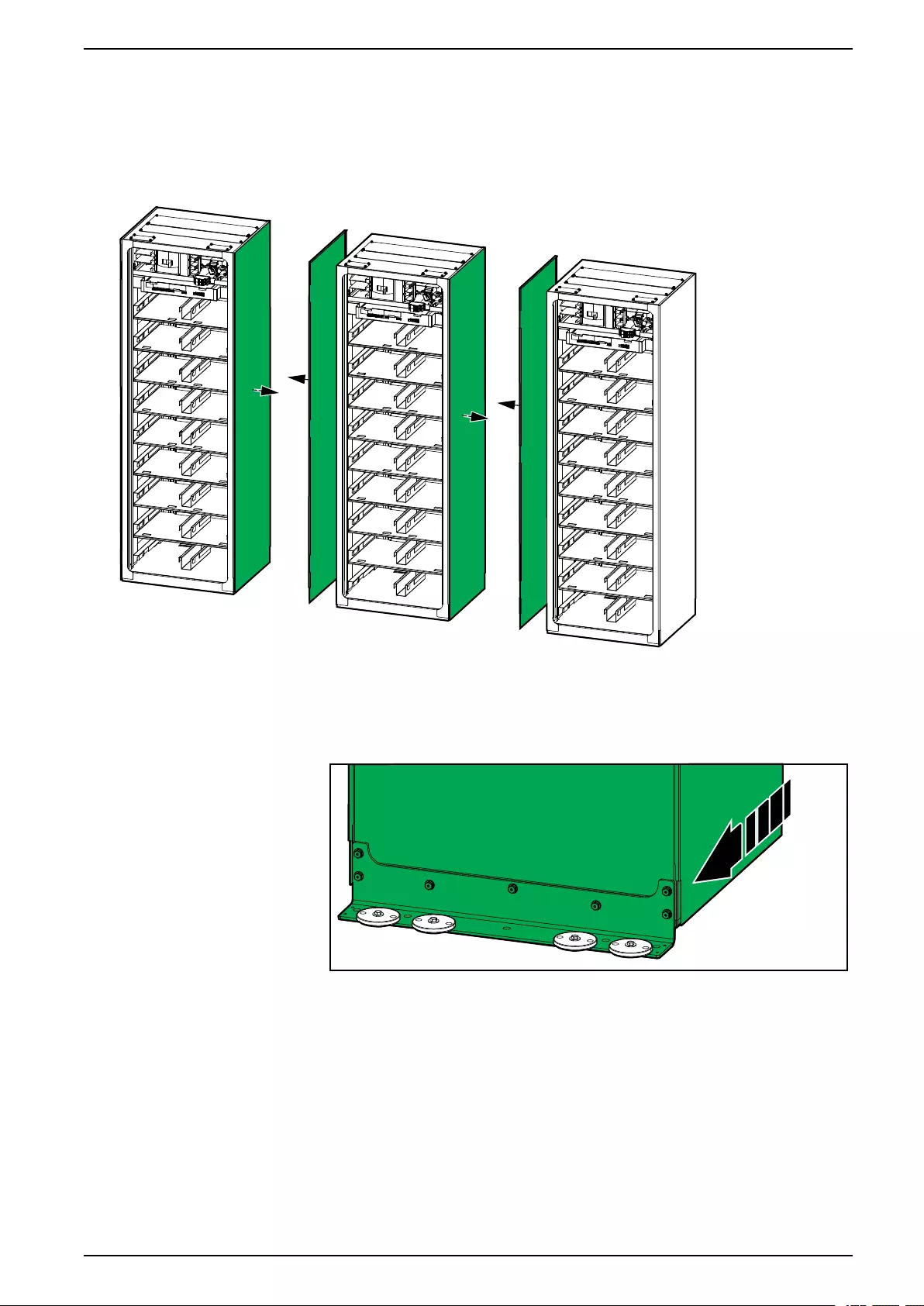
Installation Procedure With 13, 16, or 17 Battery Modules
Position and Interconnect the Battery Cabinets
NOTE: This procedure describes how to position and interconnect several
battery cabinets. If your system only has one battery cabinet, you only need to
follow step 2 and step 3.
1. Remove the side panels that are adjacent to the other battery cabinets.
2. Push the right-most battery cabinet into position. For seismic anchoring,
ensure that the rear seismic bracket connects to the rear anchors.
Rear View
990-91430A-001 19
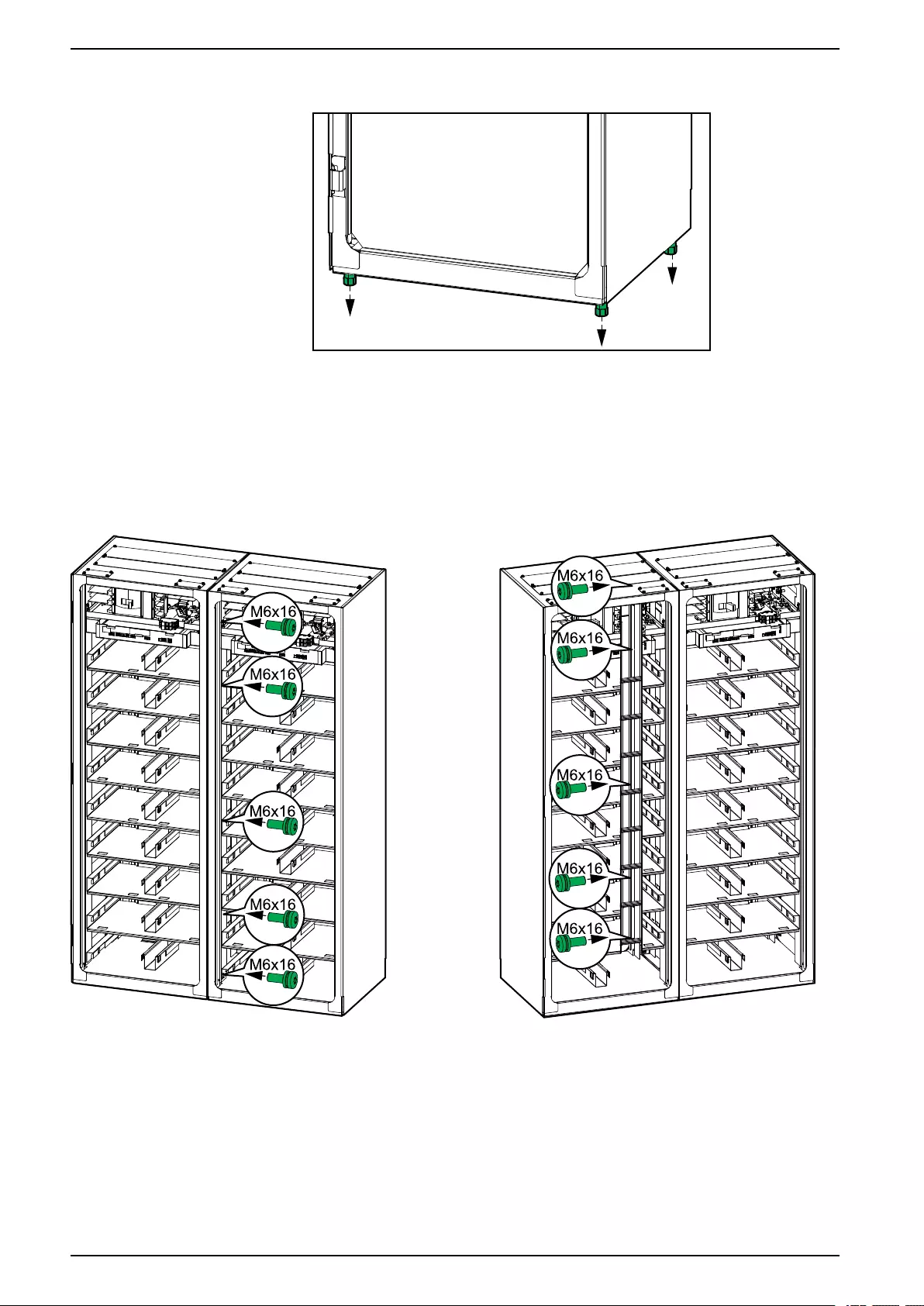
With 13, 16, or 17 Battery Modules Installation Procedure
3. Lower the levelling feet until they connect with the floor - use a bubble-leveler
to ensure that the cabinet is level.
4. Push the second right-most battery cabinet into position, align with the
seismic anchoring (if any), and level the battery cabinet as described in step 2
and step 3.
5. Install the ten interconnection screws (five in the front and five in the rear)
between the two battery cabinets.
NOTE: To reach the five interconnection screws in the rear of the left-
most battery cabinet, the left side panel can be removed. Reinstall the left
side panel on the left-most battery cabinet after interconnection.
6. Push the third battery cabinet into position, align with the seismic anchoring (if
any), level the battery cabinet, and interconnect with the other battery
cabinets as described in step 2, step 3, and step 5. Continue until all the
battery cabinets are in place, levelled, and interconnected.
20 990-91430A-001
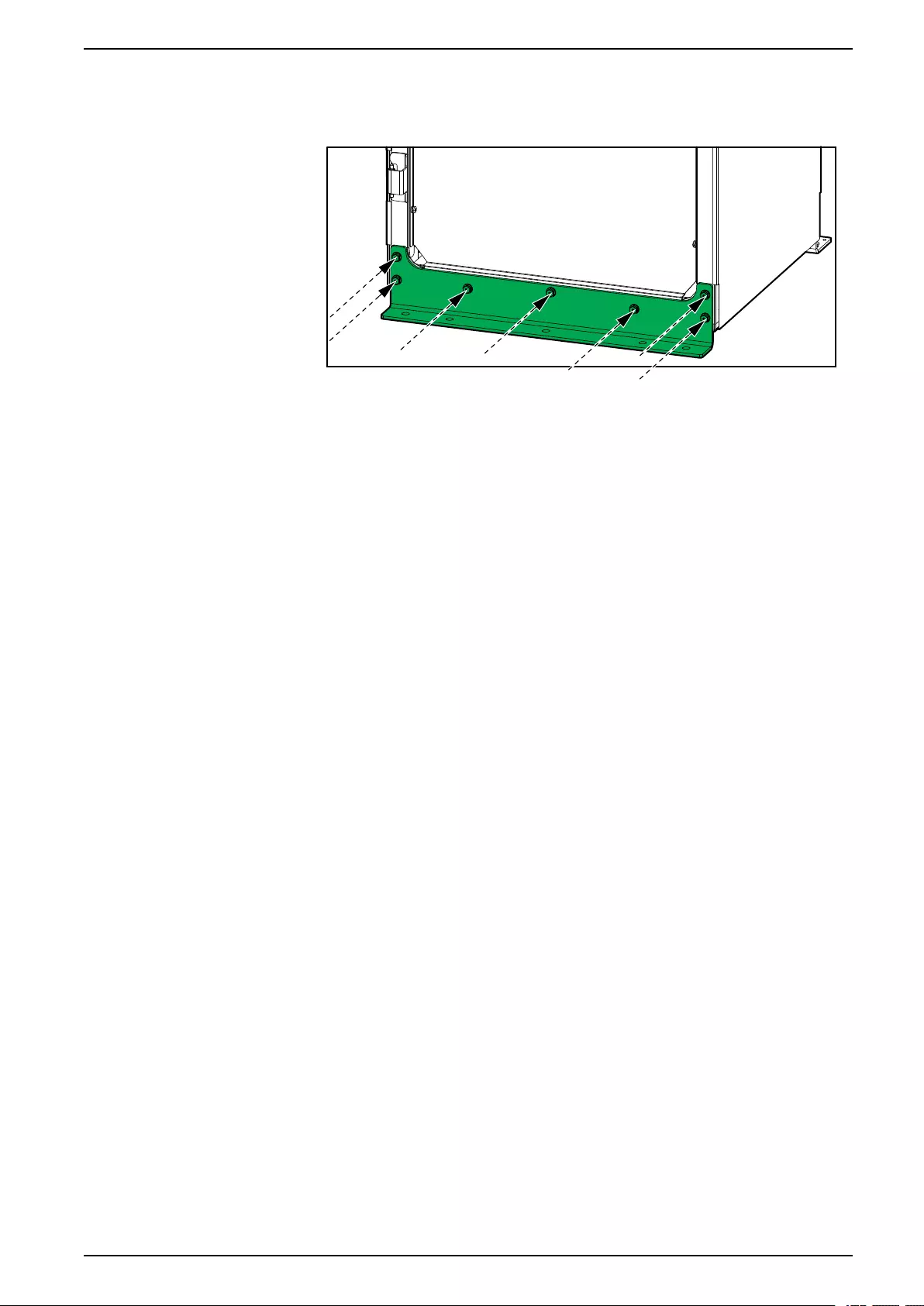
Installation Procedure With 13, 16, or 17 Battery Modules
Install the Front Seismic Anchoring
1. Install the front seismic bracket (front shipping bracket) on the battery cabinet.
2. Anchor the front seismic bracket to the floor using appropriate hardware for
the floor type – the hole diameter in the front seismic bracket is ø14 mm. The
minimum requirement is M12 strength grade 8.8 hardware.
NOTE: Floor anchoring bolts are not supplied.
990-91430A-001 21
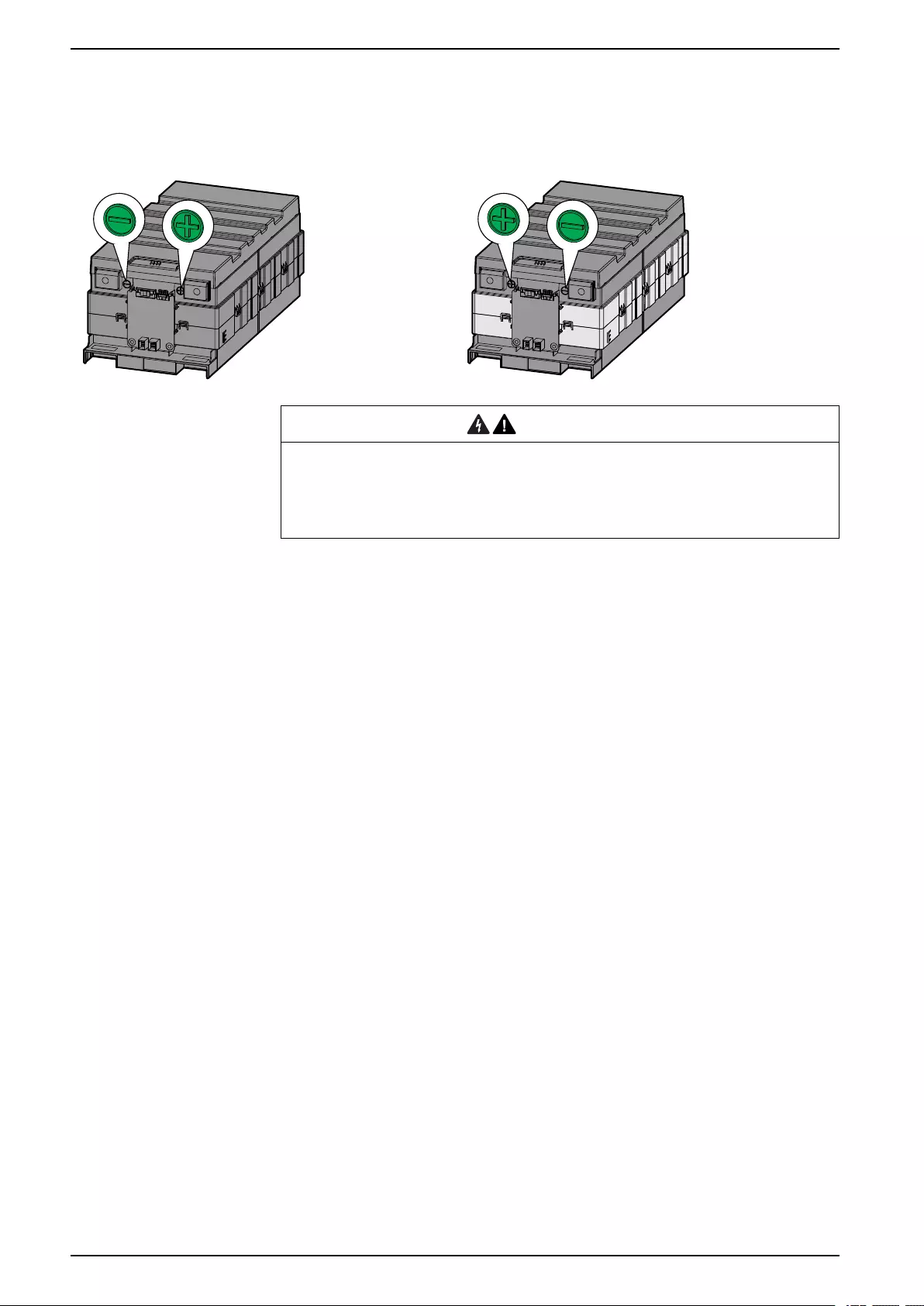
With 13, 16, or 17 Battery Modules Installation Procedure
Install the Battery Modules in the Battery Cabinet
Type A Battery Module Type B Battery Module
WARNING
HAZARD OF INJURY AND ELECTRIC SHOCK
• Be careful when installing and removing the battery modules (>17 kg).
Failure to follow these instructions can result in death, serious injury, or
equipment damage.
22 990-91430A-001
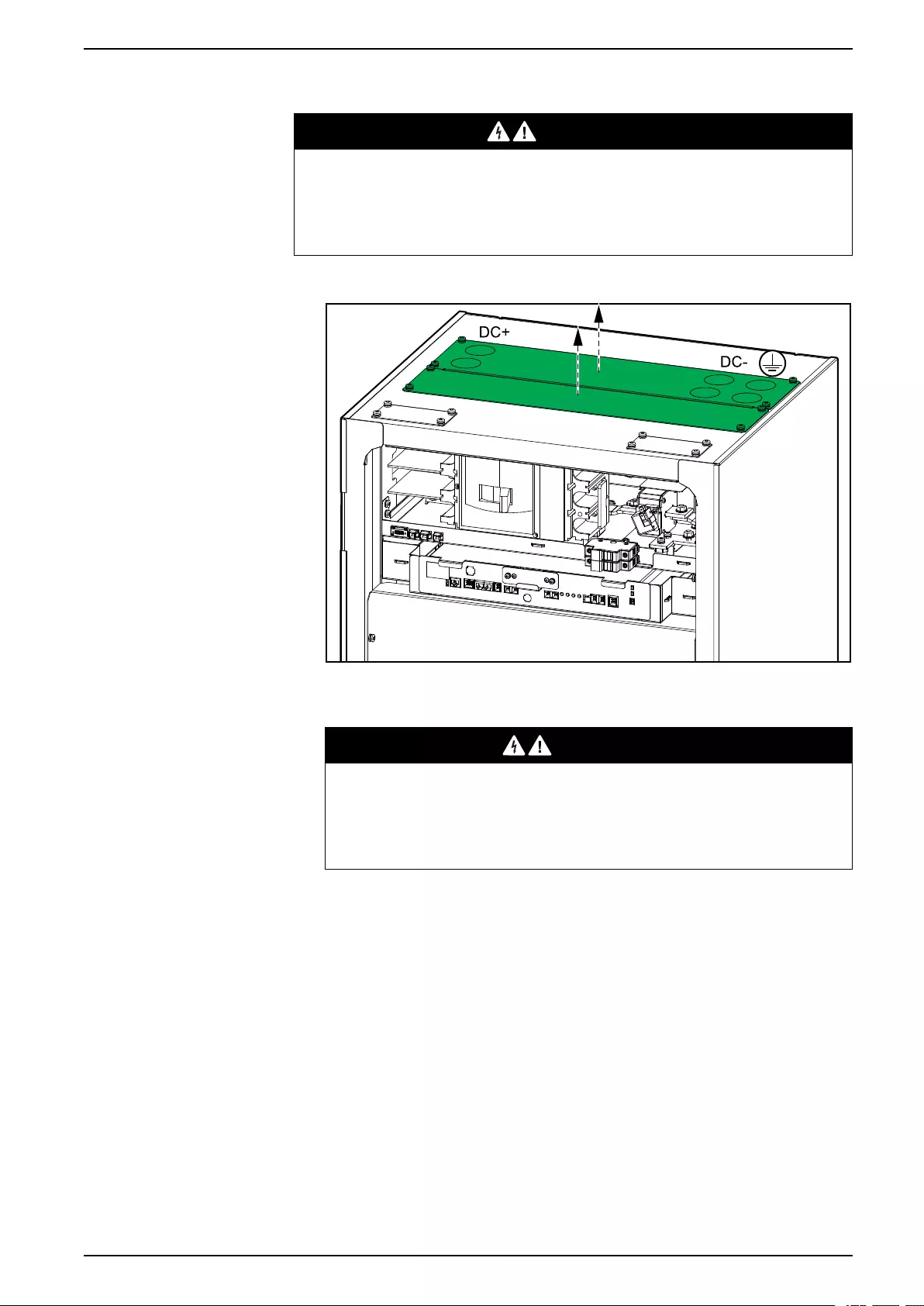
Installation Procedure With 13, 16, or 17 Battery Modules
Connect the Power Cables
DANGER
HAZARD OF ELECTRIC SHOCK, EXPLOSION, OR ARC FLASH
Do not drill or punch holes with the gland plates installed and do not drill or
punch holes in close proximity to the battery cabinet.
Failure to follow these instructions will result in death or serious injury.
1. Remove the gland plates.
2. Drill or punch holes for cables/conduits in the rear gland plate according to
the label on the gland plate.
DANGER
HAZARD OF ELECTRIC SHOCK, EXPLOSION, OR ARC FLASH
Ensure that there are no sharp edges that can damage the cables.
Failure to follow these instructions will result in death or serious
injury.
3. Install conduits (if applicable) and reinstall the gland plates.
990-91430A-001 25
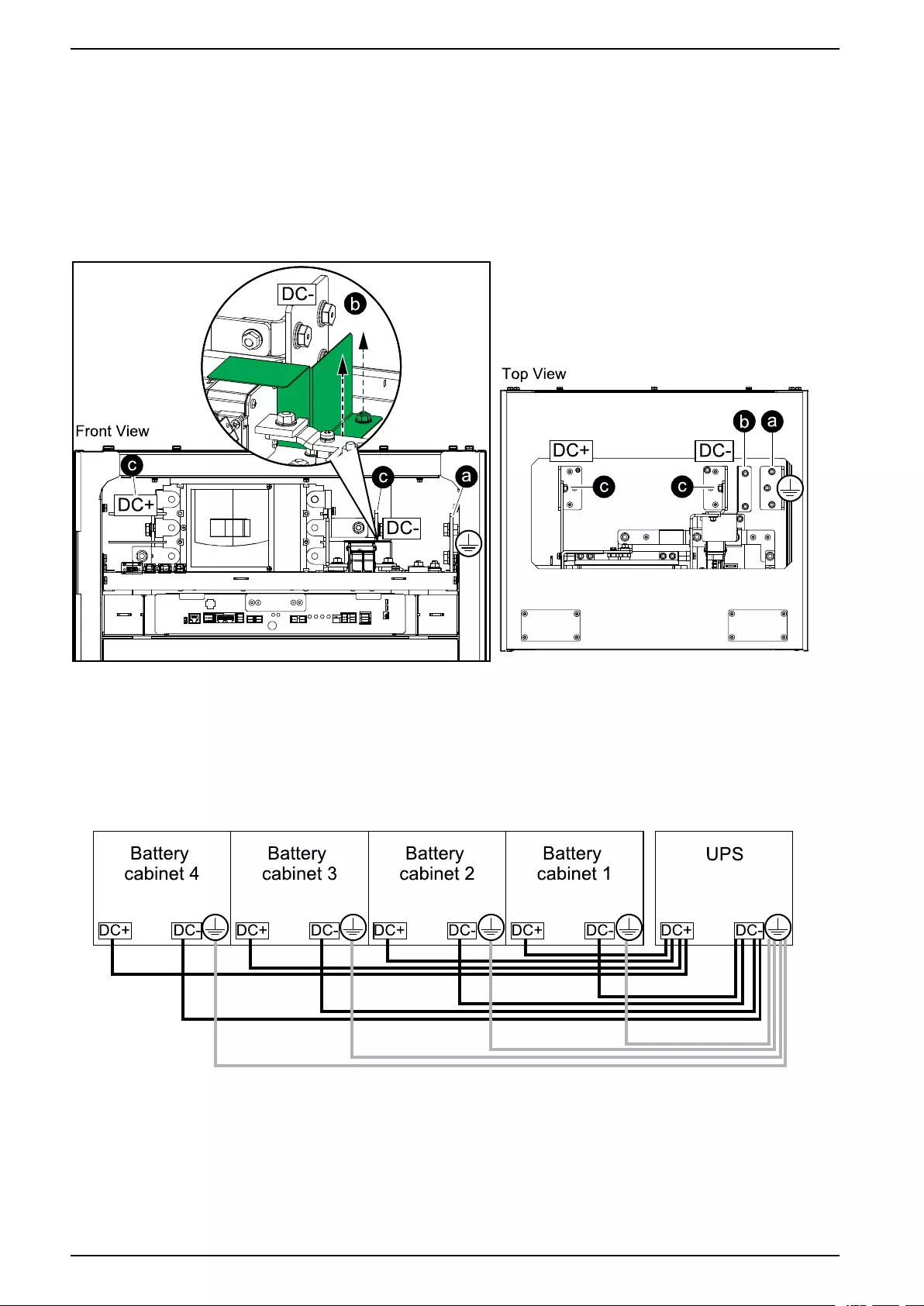
With 13, 16, or 17 Battery Modules Installation Procedure
4. Route the power cables through the gland plate and connect to the terminals:
a. Connect the PE cable to the PE terminal/Connect the EGC cable to the
grounding terminal.
b. For installations with two hole cable lugs only, temporarily remove the
protection cover.
NOTE: The protection cover must be reinstalled when the DC- cable
has been connected.
c. Connect the DC+ and DC- cables to the DC+ and DC- terminals.
5. Connect the power cables in the UPS. If more battery cabinets are part of the
solution, connect all battery cabinets to the UPS according to the diagram
below.
NOTE: If the combined short circuit current of the battery cabinets
exceeds the short circuit rating of the UPS, a pull box with fuses or an
external box with a battery breaker must be installed. Please contact
Schneider Electric for more information and refer to the submittal
drawings for your specific UPS.
26 990-91430A-001
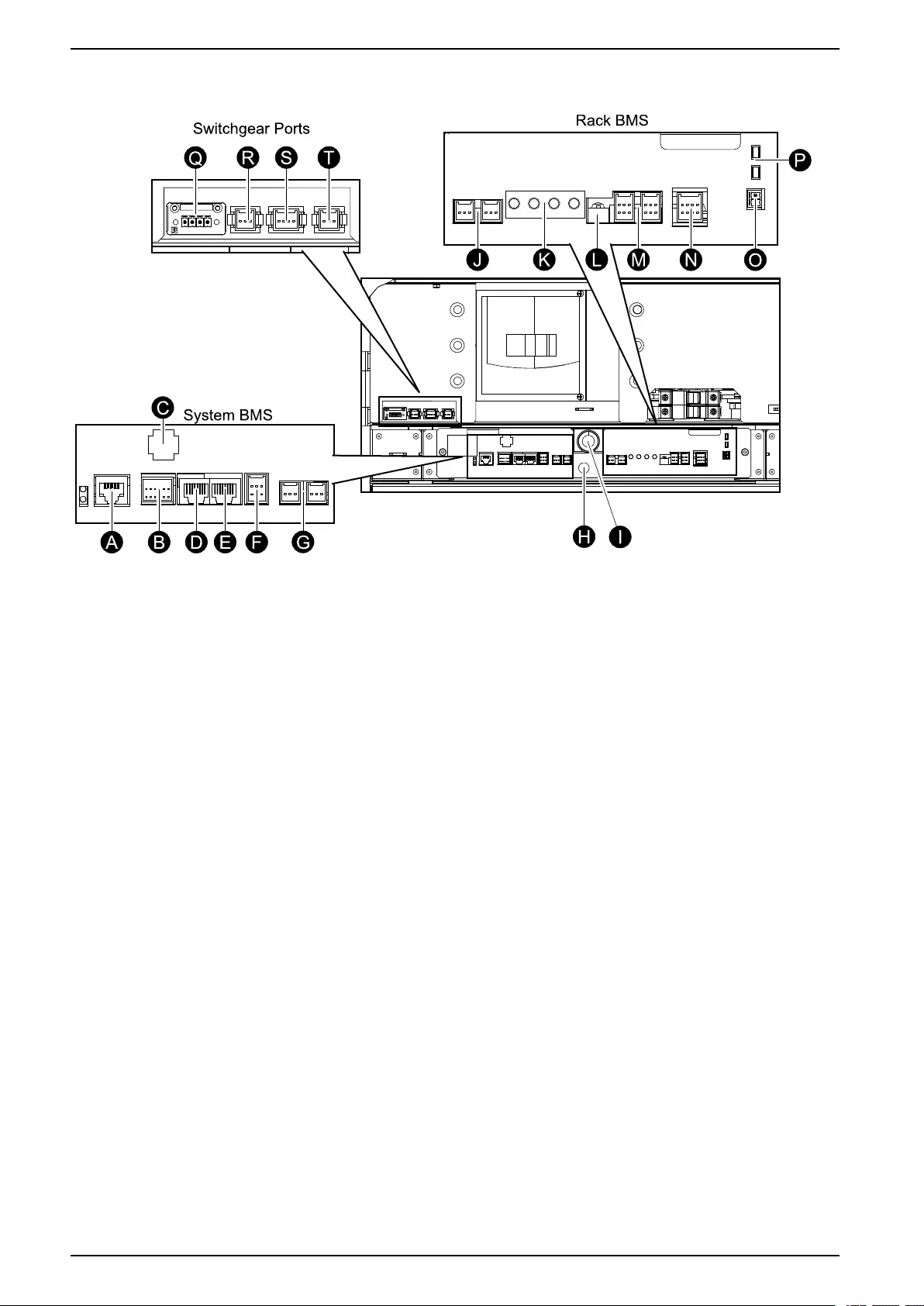
With 13, 16, or 17 Battery Modules Installation Procedure
Overview of Communication Interface
A. TCP/IP
B. Dry contact
C. SMPS I/O
D. CAN I/O
E. RS485
F. System BMS CAN I/O
G. DC OUT 1 and DC OUT 2
H. Reset switch
I. Start-up button
J. DC IN 1 and DC IN 2
K. Status LEDs
L. CAN bus loop termination resistor switch
M. CAN 1 port, CAN 2 port
N. Module
O. EPO
P. PSU 1 and PSU2 LEDs
Q. SG IO 1
R. SG IO 2
S. MCCB AUX 1
T. MCCB AUX 2
28 990-91430A-001
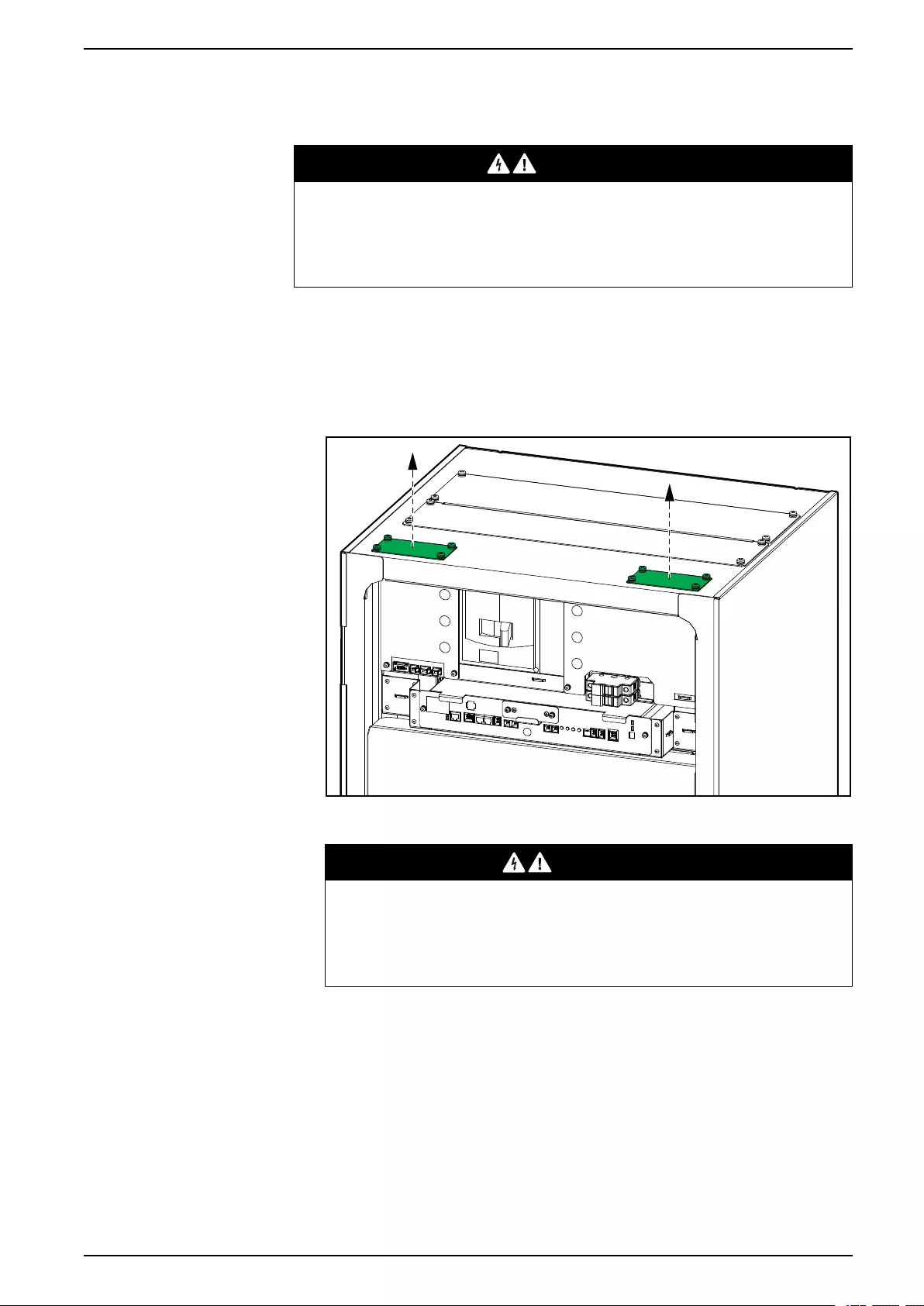
Installation Procedure With 13, 16, or 17 Battery Modules
Route the Signal Cables to the Switchgear, Rack BMS, and
System BMS Ports
DANGER
HAZARD OF ELECTRIC SHOCK, EXPLOSION, OR ARC FLASH
Do not drill or punch holes with the gland plates installed and do not drill or
punch holes in close proximity to the battery cabinet.
Failure to follow these instructions will result in death or serious injury.
NOTE: Please refer to the UPS submittal drawings to get a complete overview
of the connections before preparing for and routing the signal cables.
NOTE: The signal cables provided with the battery cabinet are 5 m (16.4 ft)
long. A 25 m (82 ft) signal cable kit LIBSEOPT001 can be ordered from
Schneider Electric.
1. Remove the gland plates for signal cables.
2. Drill or punch holes for cables/conduits and install conduits (if applicable).
DANGER
HAZARD OF ELECTRIC SHOCK, EXPLOSION, OR ARC FLASH
Ensure that there are no sharp edges that can damage the cables.
Failure to follow these instructions will result in death or serious
injury.
990-91430A-001 29
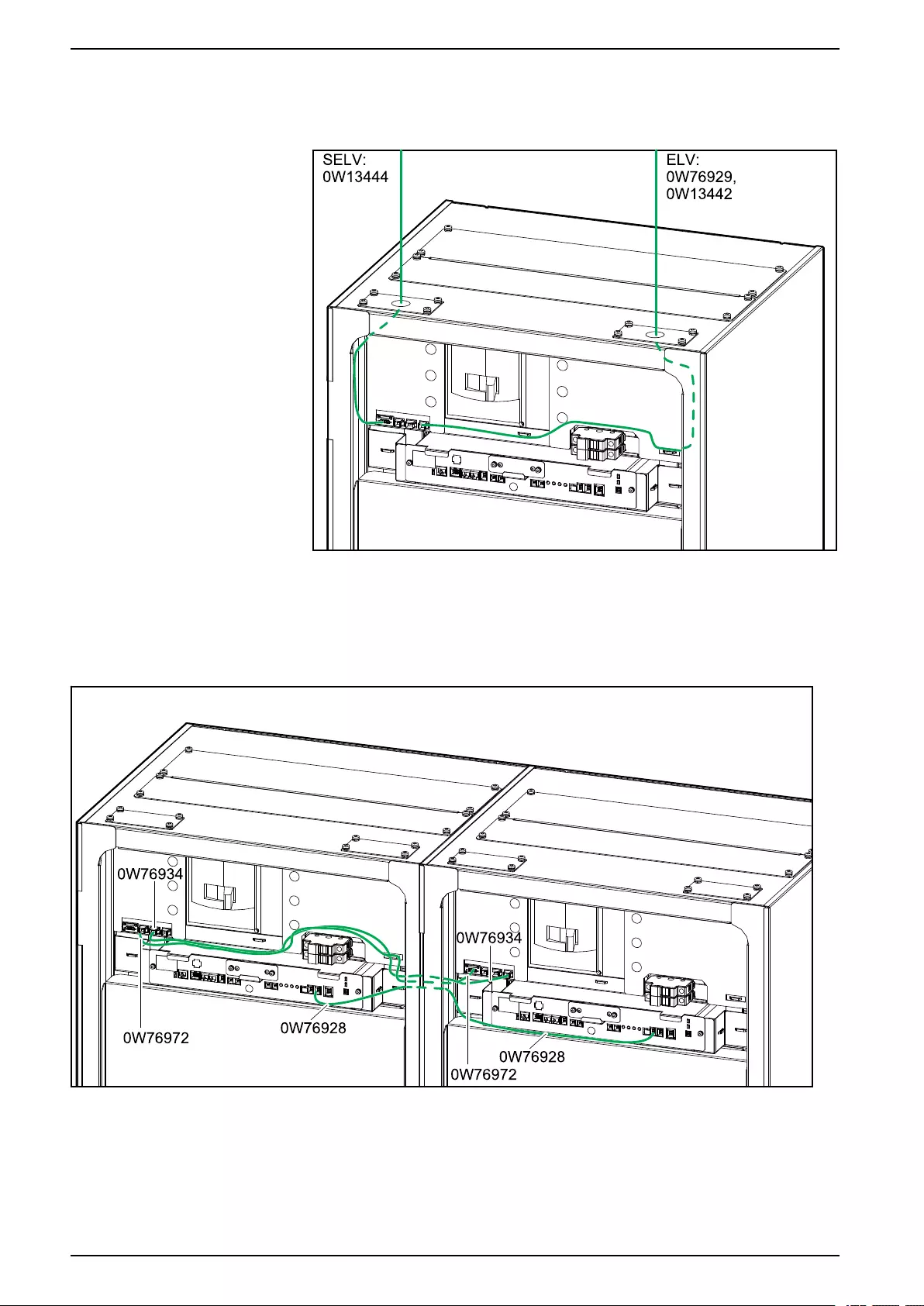
With 13, 16, or 17 Battery Modules Installation Procedure
3. Route the SELV signal cable 0W13444 and the ELV signal cables 0W76929
and 0W13442 into the battery cabinet and to the switchgear ports. Do not
connect the signal cables, Schneider Electric service will complete the
connections during start-up.
4. Route the signal cable 0W76928, 0W76934, and 0W76972 through the
openings in the sides of the battery cabinets and to the ports in the rack BMS
and the switchgear ports. Do not connect the signal cables, Schneider
Electric service will complete the connections during start-up.
NOTE: All cables between rack BMS and rack BMS as well as between
system BMS and rack BMS are considered Class 2/SELV.
30 990-91430A-001
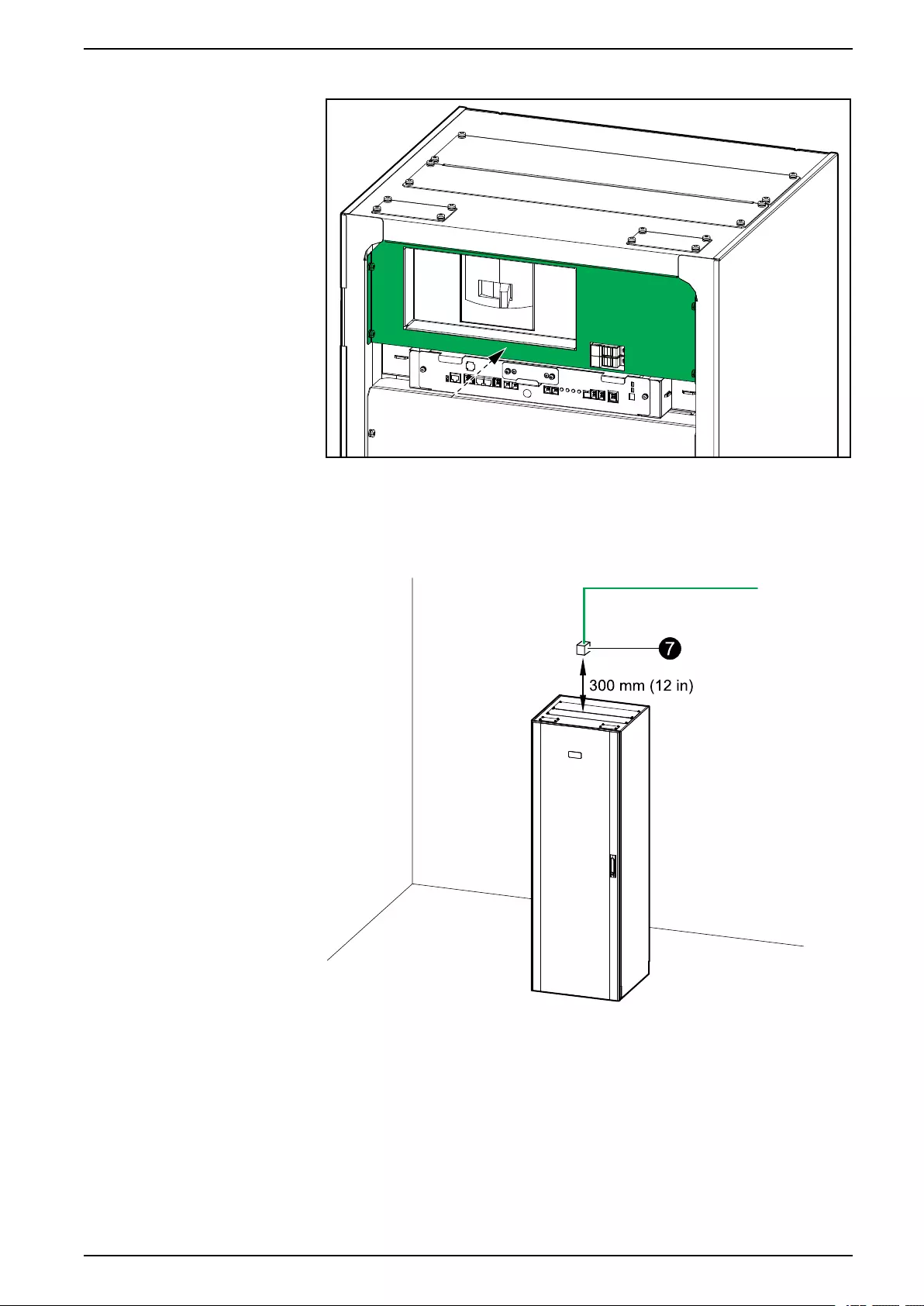
Installation Procedure With 13, 16, or 17 Battery Modules
5. Reinstall the plate in front of the battery breaker.
6. Reinstall the front door of the battery cabinet.
7. Install the temperature sensor provided with the UPS above the battery
cabinet, approximately 300 mm (12 in) from the top. Route the signal cable to
the UPS and connect according to the instructions in the UPS installation
manual.
NOTE: The temperature sensor measures the ambient temperature. Do
not place the temperature sensor close to external heating or cooling
equipment which may give an incorrect measurement of the ambient
temperature.
990-91430A-001 31
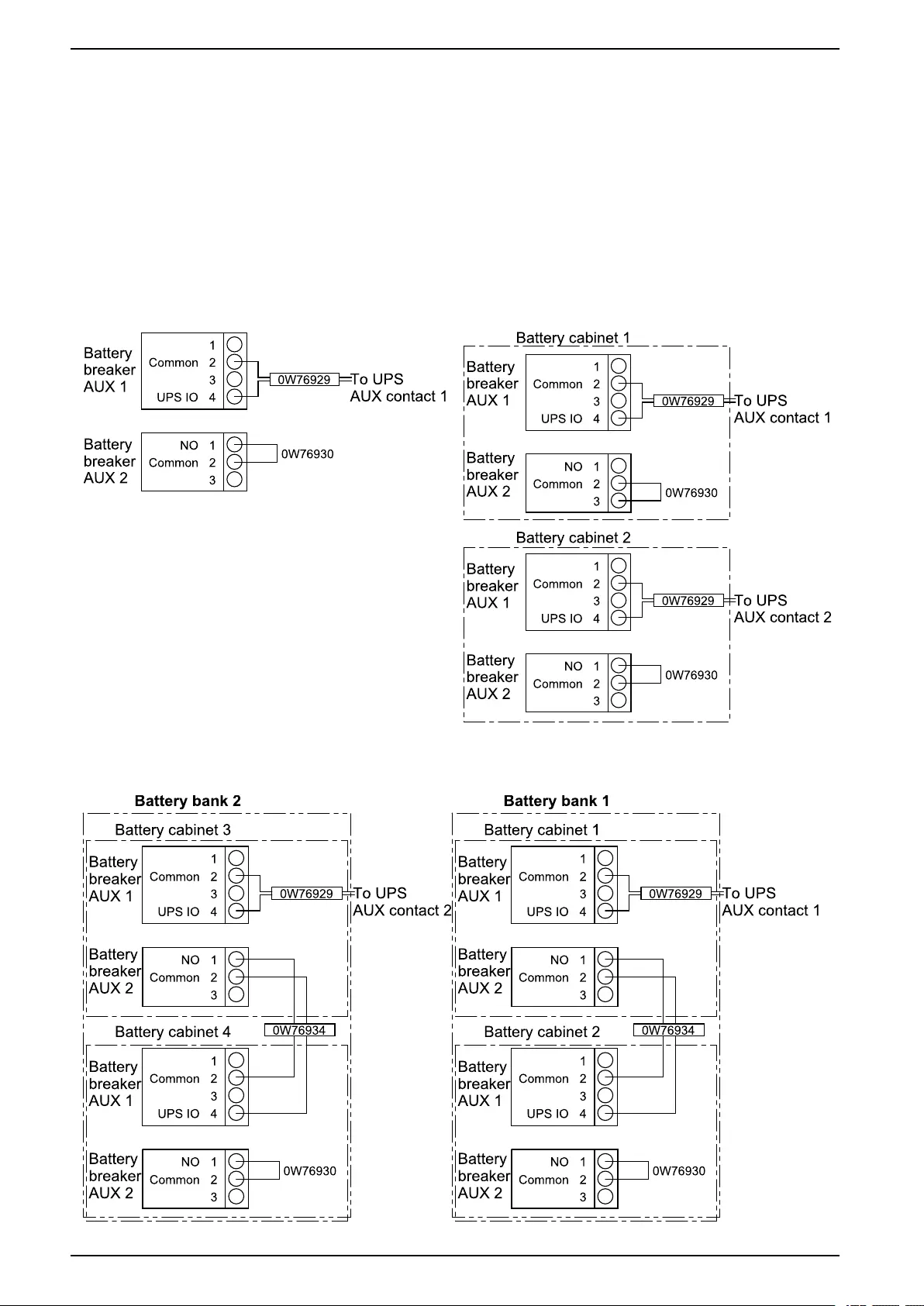
With 13, 16, or 17 Battery Modules Installation Procedure
Overview of Signal Cables between the Battery Cabinets and the Auxiliary Contacts in
the UPS
The connection of auxiliary contacts is dependent on the number of battery
breakers supported by the UPS. In the examples below two banks of battery
breakers are supported.
NOTE: If the combined short circuit current of the battery cabinets exceeds
the short circuit rating of the UPS, a pull box with fuses or an external box with
a battery breaker must be installed. Please contact Schneider Electric for
more information.
System with One Battery Cabinet System with Two Battery Cabinets
System with Four Battery Cabinets in Two Battery Banks
32 990-91430A-001
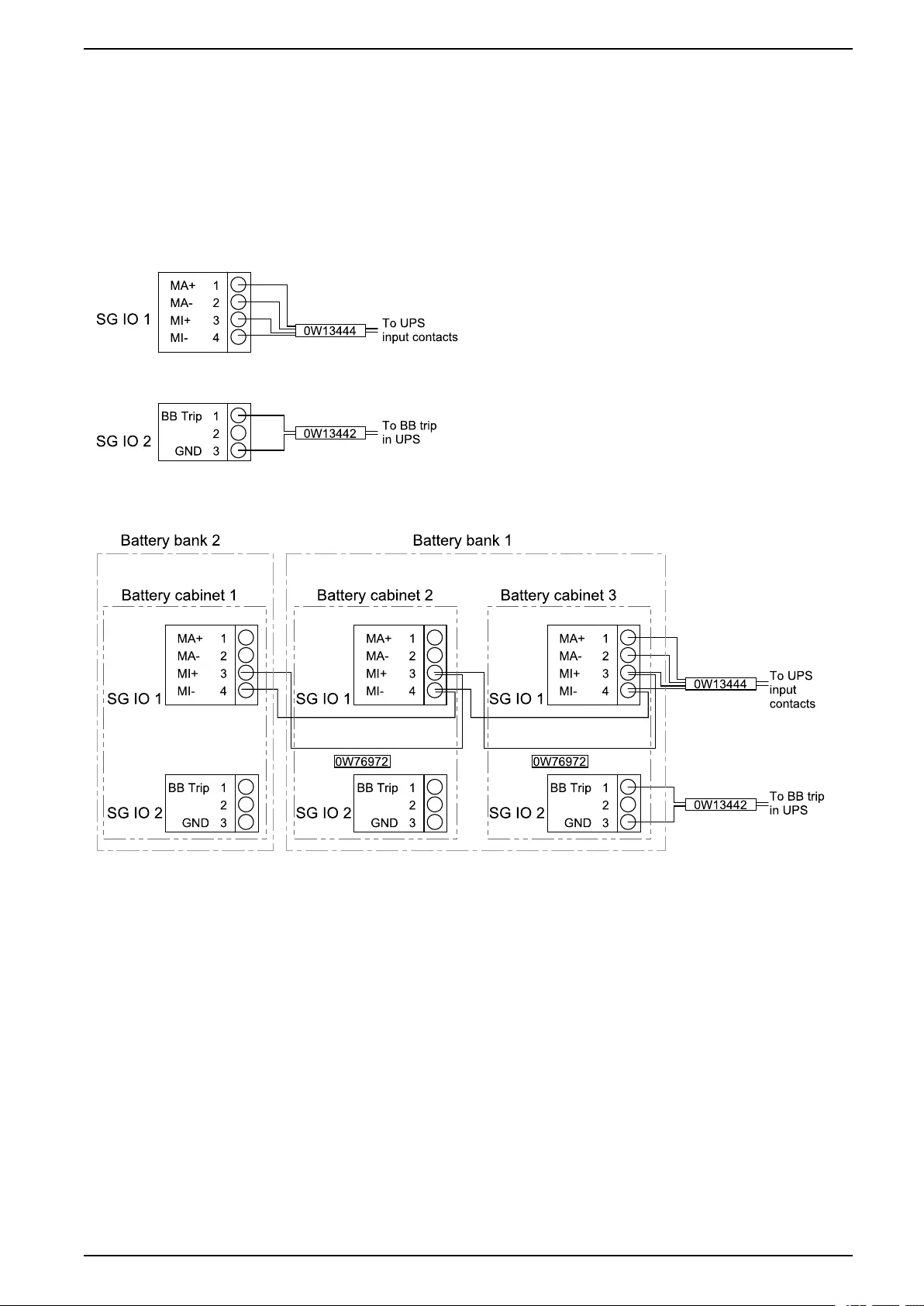
Installation Procedure With 13, 16, or 17 Battery Modules
Overview of Signal Cables for Alarms and Battery Breaker Trip
Only the system BMS of battery cabinet 1 (cabinet closest to the UPS) is
connected to the UPS.
• SG IO 1: Used for sending signals for minor and major alarms to the UPS.
• SG IO 2: Used for receiving trip signal from the UPS.
System with One Battery Cabinet
System with Three Battery Cabinets in Two Battery Banks
990-91430A-001 33
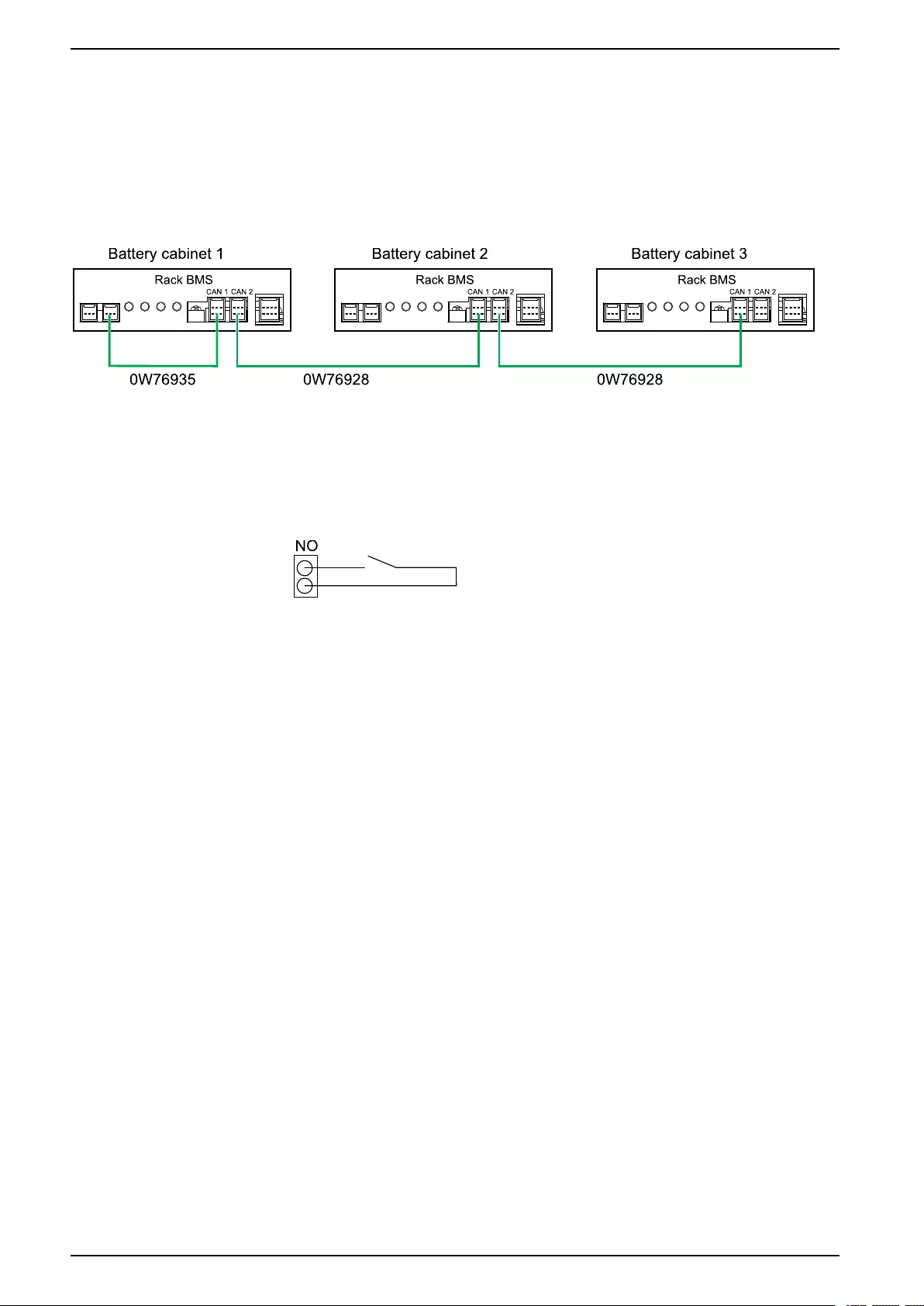
With 13, 16, or 17 Battery Modules Installation Procedure
Overview of CAN Bus Cables between the Battery Cabinets
NOTE: In systems with more battery cabinets, remove the cables 0W76935
from CAN 1 in the rack BMS to the System BMS CAN I/O except in battery
cabinet 1.
1. Route signal cable 0W76928 from CAN 2 port of battery cabinet 1 to the CAN 1
port of battery cabinet 2. Repeat for the remaining battery cabinets. Do not
connect the CAN cables, Schneider Electric service will complete the connections
during start-up.
Overview of EPO Signal Cables
Connect the Class 2/SELV signal cables from the building EPO to the rack BMS.
Class 2/SELV circuits must be isolated from the primary circuitry. Do not connect
any circuit to the EPO terminal block unless it can be confirmed that the circuit is
Class 2/SELV.
34 990-91430A-001
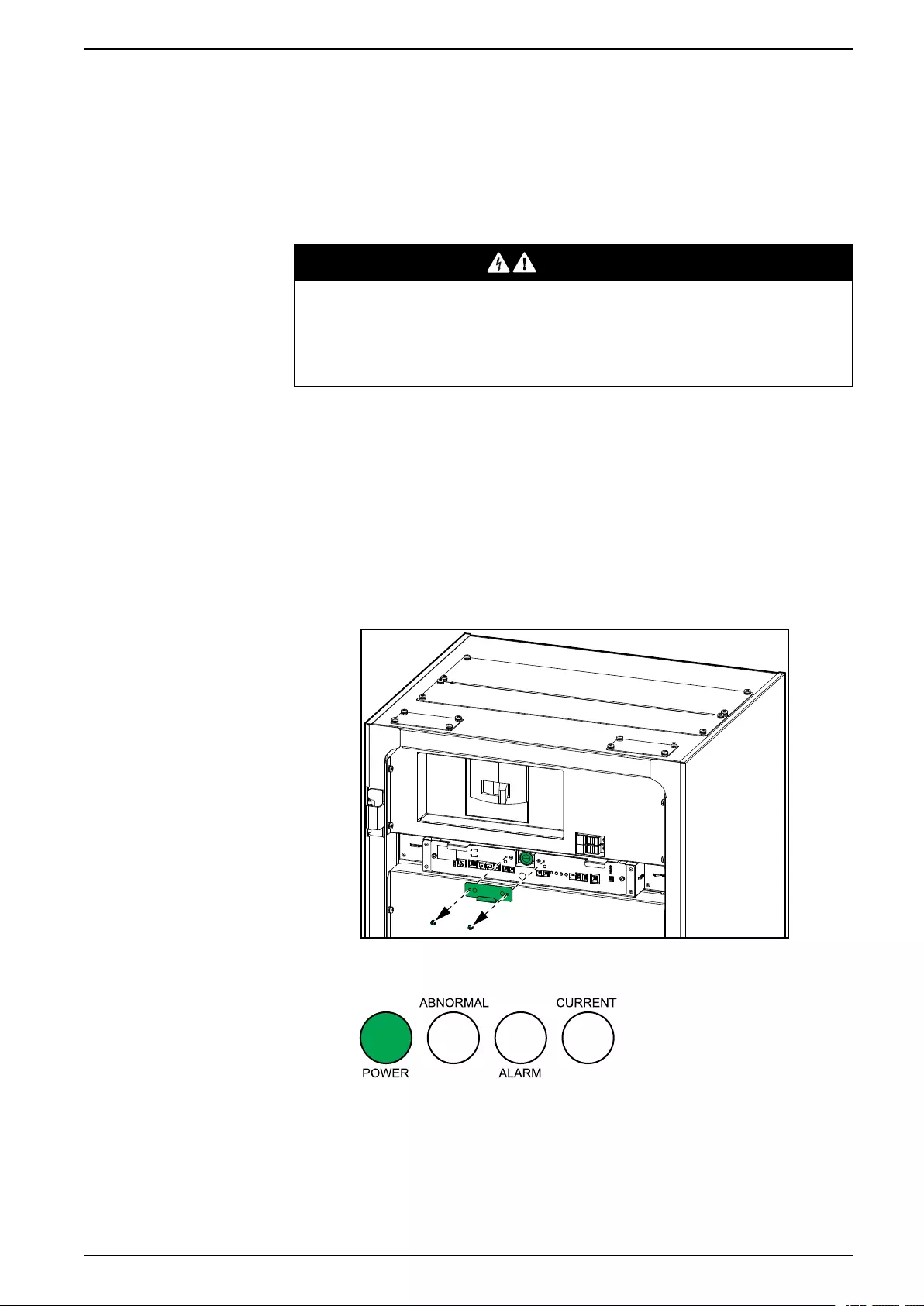
Operation Procedures With 13, 16, or 17 Battery Modules
Operation Procedures
Shut Down the Battery Solution
NOTE: This procedure is only for a short temporary shutdown of the battery
solution. If the battery solution should remain shut down for a longer period,
please contact Schneider Electric.
DANGER
HAZARD OF ELECTRIC SHOCK, EXPLOSION OR ARC FLASH
The battery cabinet contains an internal energy source. Hazardous voltage is
still present after the battery breaker has been opened.
Failure to follow these instructions will result in death or serious injury.
1. Manually set the battery breaker of each individual battery cabinet to the OFF
(open) position to disconnect the battery power from the UPS.
NOTE: The system BMS and rack BMS will still be operating.
Restart the Battery Solution
1. Perform the following steps on all battery cabinets in the battery solution.
a. Remove the cover in front of the start-up button and push the start-up
button.
• The PSU2 LED and the POWER LED will turn on.
• The ABNORMAL and ALARM LEDs should remain off.
b. Reinstall the cover in front of the start-up button.
c. Set the battery breaker to the ON (closed) position.
990-91430A-001 35
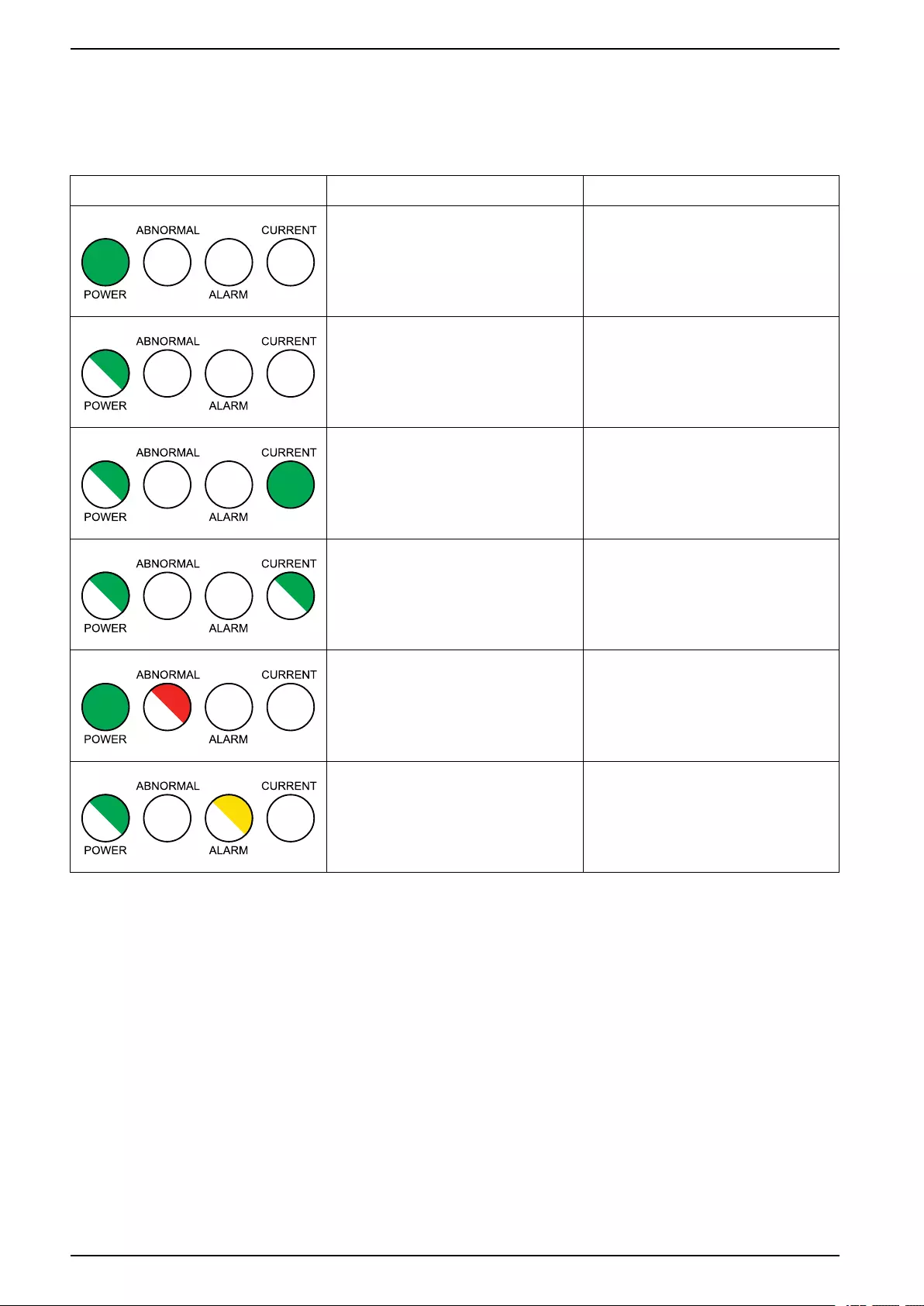
With 13, 16, or 17 Battery Modules Troubleshooting
Troubleshooting
Status LEDs
LED Battery Status Description
Normal The battery breaker is in the OFF
(open) position.
Normal The battery breaker is in the ON
(closed) position.
Normal The batteries are being
discharged.
Normal The batteries are being recharged.
Major alarm The battery breaker has tripped
and is in the OFF (open) position.
Minor alarm The battery breaker is in the ON
(closed) position.
36 990-91430A-001

With 13, 16, or 17 Battery Modules Troubleshooting
Alarm List
Protection Protocols
Protection Protocol for Battery Cabinet with 17 Battery Modules
No Item Level Set condition Soft-
ware
set
time
(sec)
Battery
breaker
status1
Release condition Time
(sec)
Battery
breaker
status
1 Over voltage protection
- cell Major Max cell ≥ 4.28 V 5 OFF Max cell <4.25 V and
reset 5ON
2 Under voltage
protection - cell Major Min cell ≤ 2.5 V 3 OFF Min cell > 2.70 V and
reset 3 ON
3 Over voltage protection
- cabinet Major Cabinet voltage ≥
582.08 V 5OFF Cabinet voltage < 578
V and reset 5ON
4 Under voltage
protection - cabinet Major Cabinet voltage ≤ 340
V3 OFF Cabinet voltage >
367.2 V and reset 3 ON
5 Voltage imbalance Major Max cell ≥ 3.80 V and
△Vcell ≥ 100 mV 5OFF △Vcell 30 mV and reset 5 ON
6 Voltage sensing error
(cabinet) Minor Cabinet V - cell sum V│
≥40.8 V
10 ON │Rack V - cell sum V│
< 20.4 V and reset
3 ON
7 Voltage sensing error
(module) Minor │Module V - cell sum
V│ ≥190 mV
5ON │Module V - cell sum
V│ < 190 mV and reset
3 ON
8 Over temperature
protection Major Max temp ≥ 75 ℃3 OFF Max temp < 65 ℃and
reset 3 ON
9 Under temperature
protection Minor Min temp ≤ 0 ℃3 ON Min temp > 5℃& reset 3 ON
10 Temperature imbalance Major Max cell T - min cell T ≥
40 ℃
30 OFF Max cell T - min cell T <
20 ℃and reset 3 ON
11 Over current protection
(charge) Major Level2 current ≥ 250 A 2 OFF |Current| < 10 A and
reset 3 ON
Major Level1 current ≥ 200 A 60 OFF |Current| < 10 A and
reset 3 ON
12 Over current protection
(discharge) Major Level4 |current| ≥ 600 A 1 OFF |Current| < 10 A and
reset 3 ON
Major Level3 |current| ≥ 540 A 10 OFF |Current| < 10 A and
reset 3 ON
Major Level2 |current| ≥ 495 A 30 OFF |Current| < 10 A and
reset 3 ON
Major Level1 |current| ≥ 470 A 60 OFF |Current| < 10 A and
reset 3 ON
13 Communication lost
(module ↔ cabinet) Major No communication 30 OFF Communication
reestablished + reset -ON
14 Communication lost
(cabinet ↔ system ) Minor No communication 30 ON Communication
reestablished + reset -ON
15 SW failure - battery
breaker Minor Battery breaker OFF
and |current| ≥ 2.4 A 3 ON (Battery breaker OFF
and (|current| < 2.4 A)
and reset
-ON
16 SW sensor failure -
battery breaker Minor Battery breaker contact
ON = battery breaker
trip ON
3 ON (Battery breaker
contact ≠ battery
breaker trip) and reset
-ON
17 Current sensing error Minor No communication with
Current IC 3 ON Communication with
current IC OK -ON
18 Fuse failure Minor Fuse blown 10 ON Fuse ON and reset -ON
38 990-91430A-001
1. The battery breaker status will switch from ON to OFF within three seconds after the software set time.

Troubleshooting With 13, 16, or 17 Battery Modules
Protection Protocol for Battery Cabinet with 16 Battery Modules
No Item Level Set condition Soft-
ware
set
time
(sec)
Battery
breaker
status2
Release condition Time
(sec)
Battery
breaker
status
1 Over voltage protection
- cell Major Max cell ≥ 4.28 V 5 OFF Max cell < 4.25 V and
reset 5ON
2 Under voltage
protection - cell Major Min cell ≤ 2.5 V 3 OFF Min cell > 2.70 V and
reset 3 ON
3 Over voltage protection
- cabinet Major Cabinet voltage ≥
547.84 V 5OFF Cabinet voltage < 544
V and reset 5ON
4 Under voltage
protection - cabinet Major Cabinet voltage ≤ 320
V3 OFF Cabinet voltage >
345.6 V and reset 3 ON
5 Voltage imbalance Major Max cell ≥ 3.80 V and
△Vcell ≥ 100 mV 5OFF △Vcell < 30 mV and
reset 5ON
6 Voltage sensing error
(cabinet) Minor Cabinet V - cell sum V│
≥38.4 V
10 ON │Rack V - cell sum V│
< 19.2 V and reset
3 ON
7 Voltage sensing error
(module) Minor │Module V - cell sum
V│ ≥190 mV
5ON │Module V - cell sum
V│ < 190 mV and reset
3 ON
8 Over temperature
protection Major Max temp ≥ 75 ℃3 OFF Max temp < 65 ℃and
reset 3 ON
9 Under temperature
protection Minor Min temp ≤ 0 ℃3 ON Min temp > 5℃& reset 3 ON
10 Temperature imbalance Major Max cell T - min cell T ≥
40 ℃
30 OFF Max cell T - min cell T <
20 ℃and reset 3 ON
11 Over current protection
(charge) Major Level2 current ≥ 250 A 2 OFF |Current| < 10 A and
reset 3 ON
Major Level1 current ≥ 200 A 60 OFF |Current| < 10 A and
reset 3 ON
12 Over current protection
(discharge) Major Level4 |current| ≥ 600 A 1 OFF |Current| < 10 A and
reset 3 ON
Major Level3 |current| ≥ 540 A 10 OFF |Current| < 10 A and
reset 3 ON
Major Level2 |current| ≥ 495 A 30 OFF |Current| < 10 A and
reset 3 ON
Major Level1 |current| ≥ 470 A 60 OFF |Current| < 10 A and
reset 3 ON
13 Communication lost
(module ↔ cabinet) Major No communication 30 OFF Communication
reestablished + reset -ON
14 Communication lost
(cabinet ↔ system ) Minor No communication 30 ON Communication
reestablished + reset -ON
15 SW failure - battery
breaker Minor Battery breaker OFF
and |current| ≥ 2.4 A 3 ON (Battery breaker OFF
and (|current| < 2.4 A)
and reset
-ON
16 SW sensor failure -
battery breaker Minor Battery breaker contact
ON = battery breaker
trip ON
3 ON (Battery breaker
contact ≠ battery
breaker trip) and reset
-ON
17 Current sensing error Minor No communication with
Current IC 3 ON Communication with
current IC OK -ON
18 Fuse failure Minor Fuse blown 10 ON Fuse ON and reset -ON
990-91430A-001 39
2. The battery breaker status will switch from ON to OFF within three seconds after the software set time.

With 13, 16, or 17 Battery Modules Troubleshooting
Protection Protocol for Battery Cabinet with 13 Battery Modules
No Item Level Set condition Soft-
ware
set
time
(sec)
Battery
breaker
status3
Release condition Time
(sec)
Battery
breaker
status
1 Over voltage protection
- cell Major Max cell ≥ 4.28 V 5 OFF Max cell <4.25 V and
reset 5ON
2 Under voltage
protection - cell Major Min cell ≤ 2.5 V 3 OFF Min cell > 2.70 V and
reset 3 ON
3 Over voltage protection
- cabinet Major Cabinet voltage ≥
445.12 V 5OFF Cabinet voltage < 442
V and reset 5ON
4 Under voltage
protection - cabinet Major Cabinet voltage ≤ 260
V3 OFF Cabinet voltage >
280.8 V and reset 3 ON
5 Voltage imbalance Major Max cell ≥ 3.80 V and
△Vcell ≥ 100 mV 5OFF △Vcell < 30 mV and
reset 5ON
6 Voltage sensing error
(cabinet) Minor Cabinet V - cell sum V│
≥31.2 V
10 ON │Rack V - cell sum V│
< 15.6 V and reset
3 ON
7 Voltage sensing error
(module) Minor │Module V - cell sum
V│ ≥190 mV
5ON │Module V - cell sum
V│ < 190 mV and reset
3 ON
8 Over temperature
protection Major Max temp ≥ 75 ℃3 OFF Max temp < 65 ℃and
reset 3 ON
9 Under temperature
protection Minor Min temp ≤ 0 ℃3 ON Min temp > 5℃& reset 3 ON
10 Temperature imbalance Major Max cell T - min cell T ≥
40 ℃
30 OFF Max cell T - min cell T <
20 ℃and reset 3 ON
11 Over current protection
(charge) Major Level2 current ≥ 250 A 2 OFF |Current| < 10 A and
reset 3 ON
Major Level1 current ≥ 200 A 60 OFF |Current| < 10 A and
reset 3 ON
12 Over current protection
(discharge) Major Level4 |current| ≥ 600 A 1 OFF |Current| < 10 A and
reset 3 ON
Major Level3 |current| ≥ 540 A 10 OFF |Current| < 10 A and
reset 3 ON
Major Level2 |current| ≥ 495 A 30 OFF |Current| < 10 A and
reset 3 ON
Major Level1 |current| ≥ 470 A 60 OFF |Current| < 10 A and
reset 3 ON
13 Communication lost
(module ↔ cabinet) Major No communication 30 OFF Communication
reestablished + reset -ON
14 Communication lost
(cabinet ↔ system ) Minor No communication 30 ON Communication
reestablished + reset -ON
15 SW failure - battery
breaker Minor Battery breaker OFF
and |current| ≥ 2.4 A 3 ON (Battery breaker OFF
and (|current| < 2.4 A)
and reset
-ON
16 SW sensor failure -
battery breaker Minor Battery breaker contact
ON = battery breaker
trip ON
3 ON (Battery breaker
contact ≠ battery
breaker trip) and reset
-ON
17 Current sensing error Minor No communication with
Current IC 3 ON Communication with
current IC OK -ON
18 Fuse failure Minor Fuse blown 10 ON Fuse ON and reset -ON
40 990-91430A-001
3. The battery breaker status will switch from ON to OFF within three seconds after the software set time.




Schneider Electric
35 rue Joseph Monier
92500 Rueil Malmaison
France
+ 33 (0) 1 41 29 70 00
*990-91430A-001*
As standards, specifications, and design change from time to time,
please ask for confirmation of the information given in this publication.
© 2021 – 2021 Schneider Electric. All rights reserved.
990-91430A-001
